Managing Cultural Diversity in Amazon UK Warehouses - A Case Study | Desklib
VerifiedAdded on 2023/06/18
|24
|8437
|383
AI Summary
Learn about the impact of cultural diversity on organizational management in Amazon UK warehouses through a case study. Explore the literature review on organizational culture, workforce diversity, and intra-group conflict. Discover the research objectives and questions, methodology, and limitations.
Contribute Materials
Your contribution can guide someone’s learning journey. Share your
documents today.
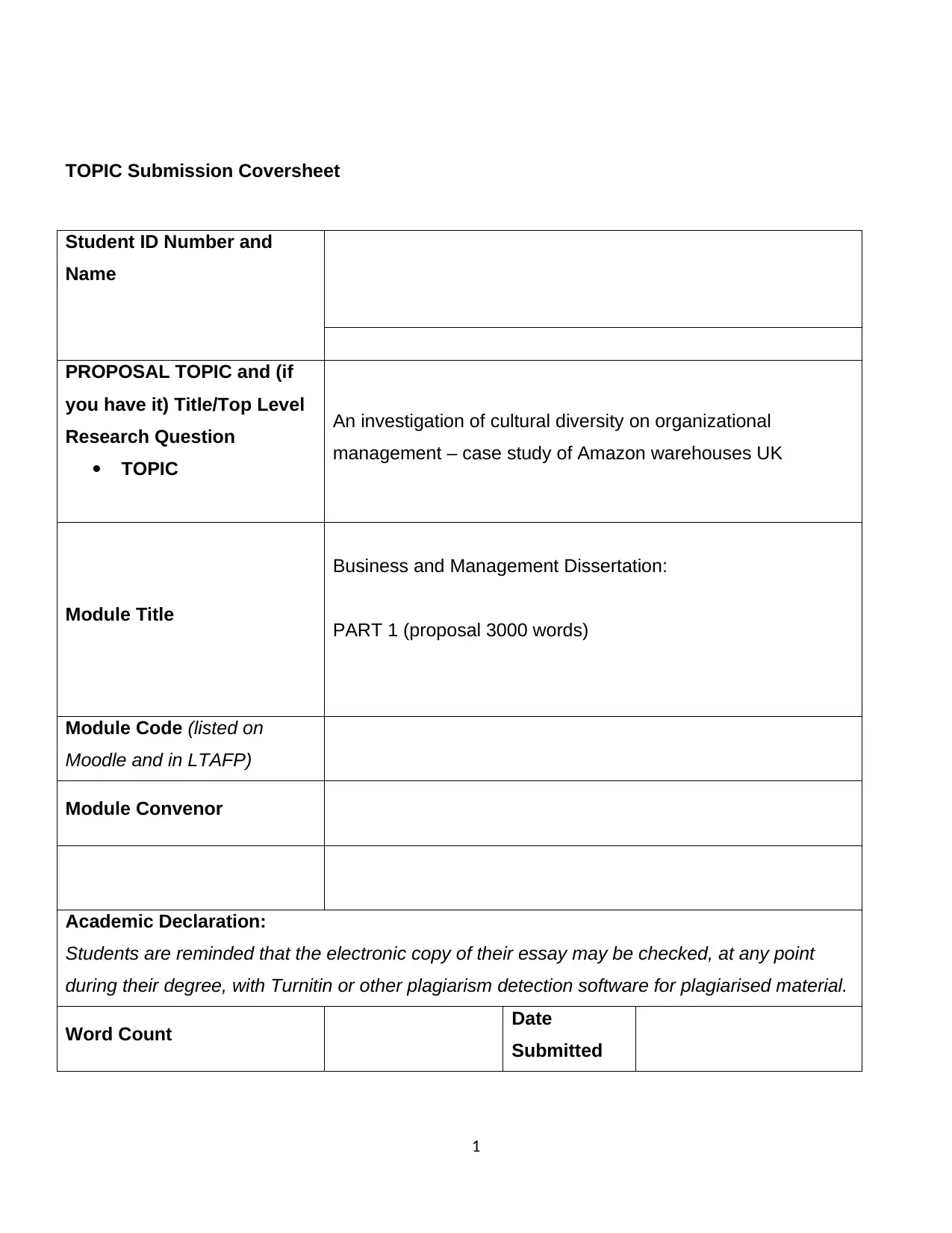
TOPIC Submission Coversheet
Student ID Number and
Name
PROPOSAL TOPIC and (if
you have it) Title/Top Level
Research Question
TOPIC
An investigation of cultural diversity on organizational
management – case study of Amazon warehouses UK
Module Title
Business and Management Dissertation:
PART 1 (proposal 3000 words)
Module Code (listed on
Moodle and in LTAFP)
Module Convenor
Academic Declaration:
Students are reminded that the electronic copy of their essay may be checked, at any point
during their degree, with Turnitin or other plagiarism detection software for plagiarised material.
Word Count Date
Submitted
1
Student ID Number and
Name
PROPOSAL TOPIC and (if
you have it) Title/Top Level
Research Question
TOPIC
An investigation of cultural diversity on organizational
management – case study of Amazon warehouses UK
Module Title
Business and Management Dissertation:
PART 1 (proposal 3000 words)
Module Code (listed on
Moodle and in LTAFP)
Module Convenor
Academic Declaration:
Students are reminded that the electronic copy of their essay may be checked, at any point
during their degree, with Turnitin or other plagiarism detection software for plagiarised material.
Word Count Date
Submitted
1
Secure Best Marks with AI Grader
Need help grading? Try our AI Grader for instant feedback on your assignments.
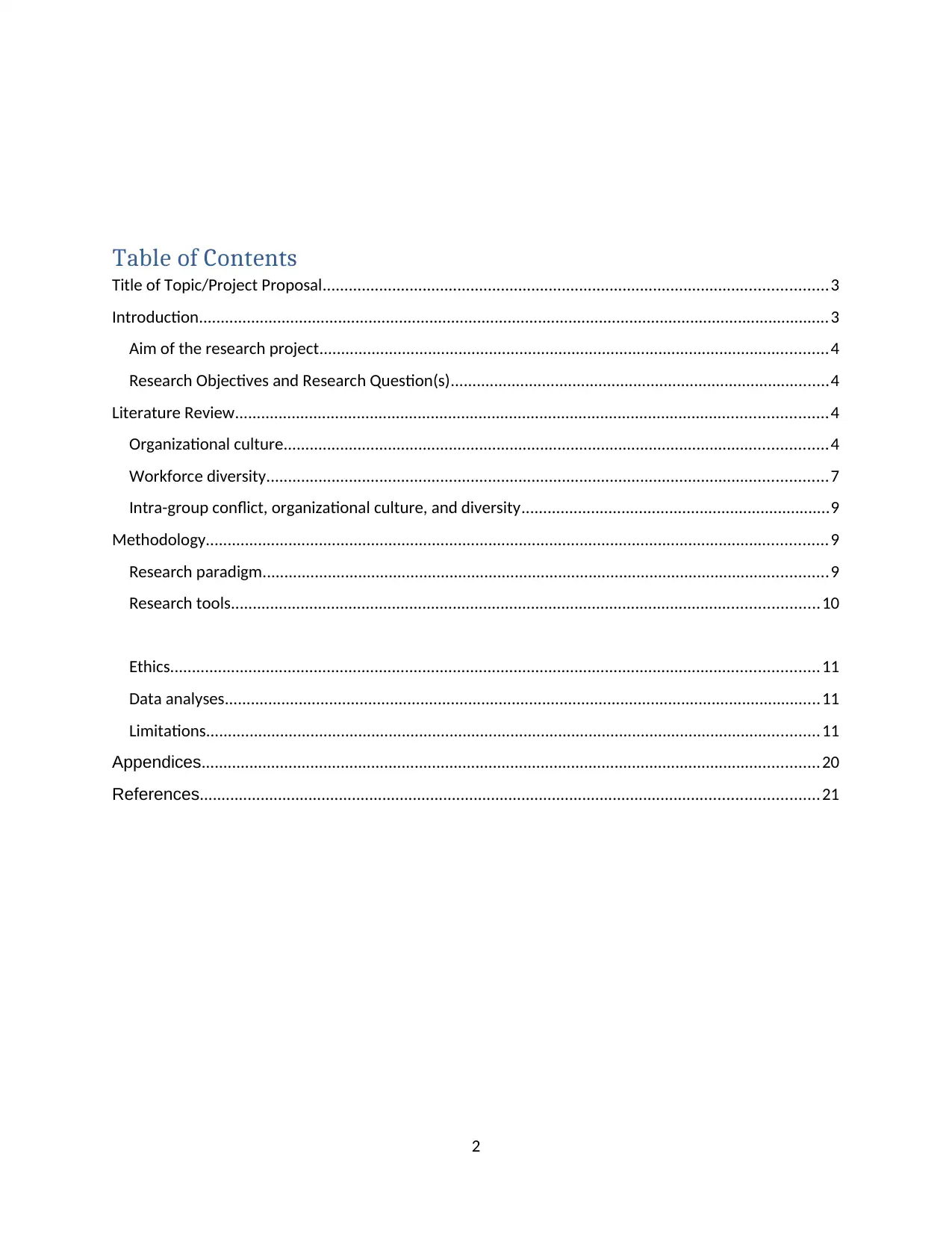
Table of Contents
Title of Topic/Project Proposal....................................................................................................................3
Introduction.................................................................................................................................................3
Aim of the research project.....................................................................................................................4
Research Objectives and Research Question(s).......................................................................................4
Literature Review........................................................................................................................................4
Organizational culture.............................................................................................................................4
Workforce diversity.................................................................................................................................7
Intra-group conflict, organizational culture, and diversity.......................................................................9
Methodology...............................................................................................................................................9
Research paradigm..................................................................................................................................9
Research tools.......................................................................................................................................10
Ethics.....................................................................................................................................................11
Data analyses.........................................................................................................................................11
Limitations.............................................................................................................................................11
Appendices..............................................................................................................................................20
References..............................................................................................................................................21
2
Title of Topic/Project Proposal....................................................................................................................3
Introduction.................................................................................................................................................3
Aim of the research project.....................................................................................................................4
Research Objectives and Research Question(s).......................................................................................4
Literature Review........................................................................................................................................4
Organizational culture.............................................................................................................................4
Workforce diversity.................................................................................................................................7
Intra-group conflict, organizational culture, and diversity.......................................................................9
Methodology...............................................................................................................................................9
Research paradigm..................................................................................................................................9
Research tools.......................................................................................................................................10
Ethics.....................................................................................................................................................11
Data analyses.........................................................................................................................................11
Limitations.............................................................................................................................................11
Appendices..............................................................................................................................................20
References..............................................................................................................................................21
2
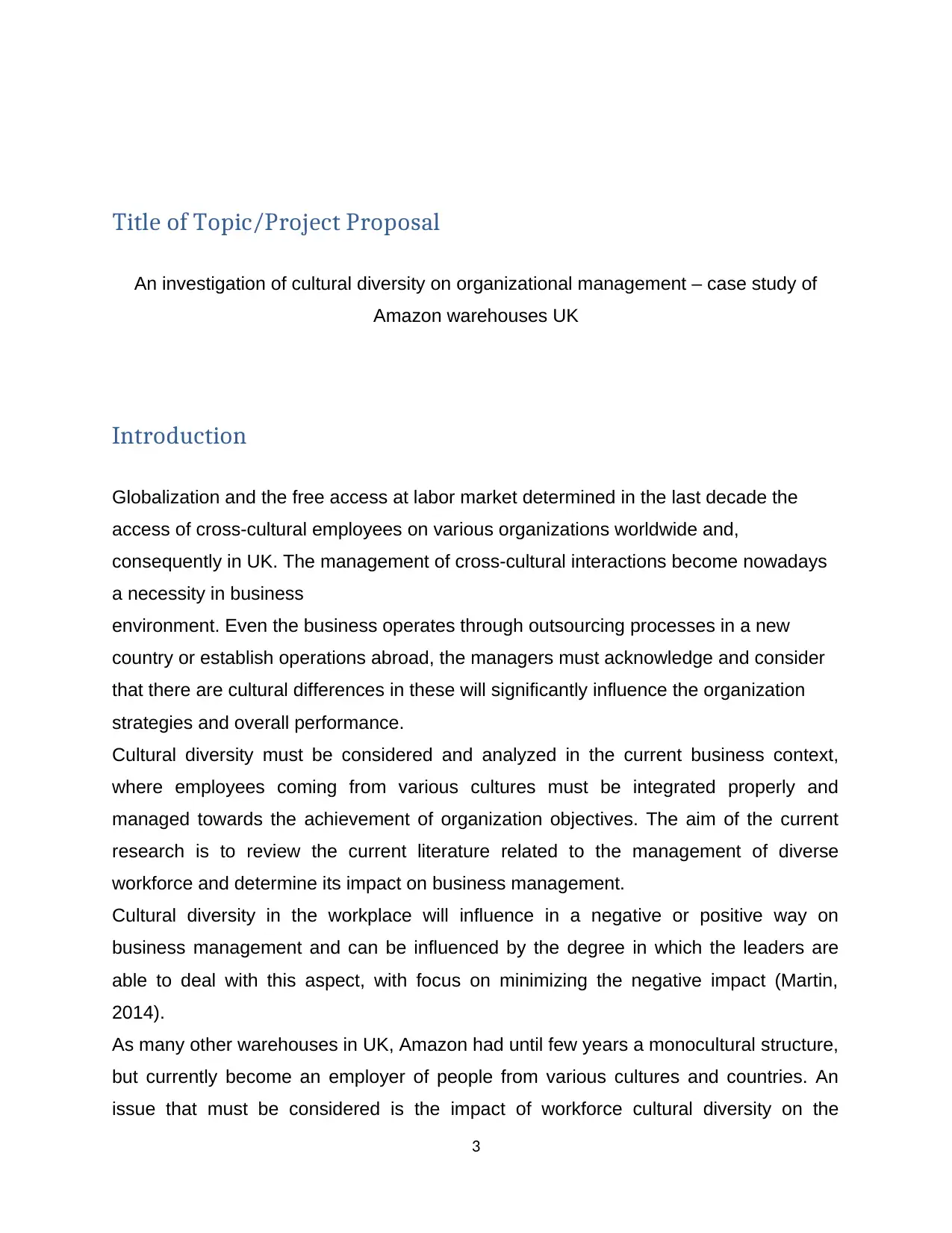
Title of Topic/Project Proposal
An investigation of cultural diversity on organizational management – case study of
Amazon warehouses UK
Introduction
Globalization and the free access at labor market determined in the last decade the
access of cross-cultural employees on various organizations worldwide and,
consequently in UK. The management of cross-cultural interactions become nowadays
a necessity in business
environment. Even the business operates through outsourcing processes in a new
country or establish operations abroad, the managers must acknowledge and consider
that there are cultural differences in these will significantly influence the organization
strategies and overall performance.
Cultural diversity must be considered and analyzed in the current business context,
where employees coming from various cultures must be integrated properly and
managed towards the achievement of organization objectives. The aim of the current
research is to review the current literature related to the management of diverse
workforce and determine its impact on business management.
Cultural diversity in the workplace will influence in a negative or positive way on
business management and can be influenced by the degree in which the leaders are
able to deal with this aspect, with focus on minimizing the negative impact (Martin,
2014).
As many other warehouses in UK, Amazon had until few years a monocultural structure,
but currently become an employer of people from various cultures and countries. An
issue that must be considered is the impact of workforce cultural diversity on the
3
An investigation of cultural diversity on organizational management – case study of
Amazon warehouses UK
Introduction
Globalization and the free access at labor market determined in the last decade the
access of cross-cultural employees on various organizations worldwide and,
consequently in UK. The management of cross-cultural interactions become nowadays
a necessity in business
environment. Even the business operates through outsourcing processes in a new
country or establish operations abroad, the managers must acknowledge and consider
that there are cultural differences in these will significantly influence the organization
strategies and overall performance.
Cultural diversity must be considered and analyzed in the current business context,
where employees coming from various cultures must be integrated properly and
managed towards the achievement of organization objectives. The aim of the current
research is to review the current literature related to the management of diverse
workforce and determine its impact on business management.
Cultural diversity in the workplace will influence in a negative or positive way on
business management and can be influenced by the degree in which the leaders are
able to deal with this aspect, with focus on minimizing the negative impact (Martin,
2014).
As many other warehouses in UK, Amazon had until few years a monocultural structure,
but currently become an employer of people from various cultures and countries. An
issue that must be considered is the impact of workforce cultural diversity on the
3
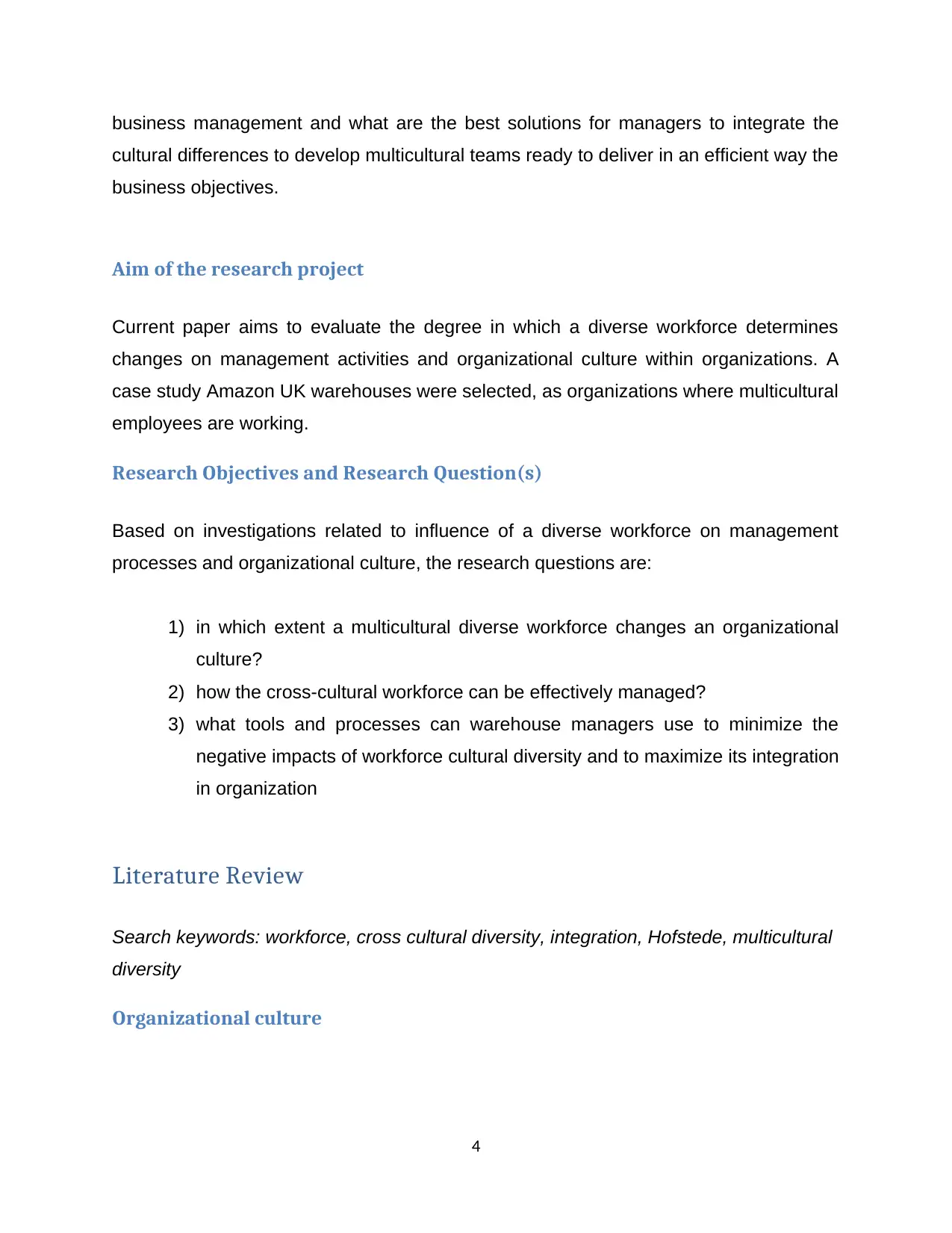
business management and what are the best solutions for managers to integrate the
cultural differences to develop multicultural teams ready to deliver in an efficient way the
business objectives.
Aim of the research project
Current paper aims to evaluate the degree in which a diverse workforce determines
changes on management activities and organizational culture within organizations. A
case study Amazon UK warehouses were selected, as organizations where multicultural
employees are working.
Research Objectives and Research Question(s)
Based on investigations related to influence of a diverse workforce on management
processes and organizational culture, the research questions are:
1) in which extent a multicultural diverse workforce changes an organizational
culture?
2) how the cross-cultural workforce can be effectively managed?
3) what tools and processes can warehouse managers use to minimize the
negative impacts of workforce cultural diversity and to maximize its integration
in organization
Literature Review
Search keywords: workforce, cross cultural diversity, integration, Hofstede, multicultural
diversity
Organizational culture
4
cultural differences to develop multicultural teams ready to deliver in an efficient way the
business objectives.
Aim of the research project
Current paper aims to evaluate the degree in which a diverse workforce determines
changes on management activities and organizational culture within organizations. A
case study Amazon UK warehouses were selected, as organizations where multicultural
employees are working.
Research Objectives and Research Question(s)
Based on investigations related to influence of a diverse workforce on management
processes and organizational culture, the research questions are:
1) in which extent a multicultural diverse workforce changes an organizational
culture?
2) how the cross-cultural workforce can be effectively managed?
3) what tools and processes can warehouse managers use to minimize the
negative impacts of workforce cultural diversity and to maximize its integration
in organization
Literature Review
Search keywords: workforce, cross cultural diversity, integration, Hofstede, multicultural
diversity
Organizational culture
4
Secure Best Marks with AI Grader
Need help grading? Try our AI Grader for instant feedback on your assignments.
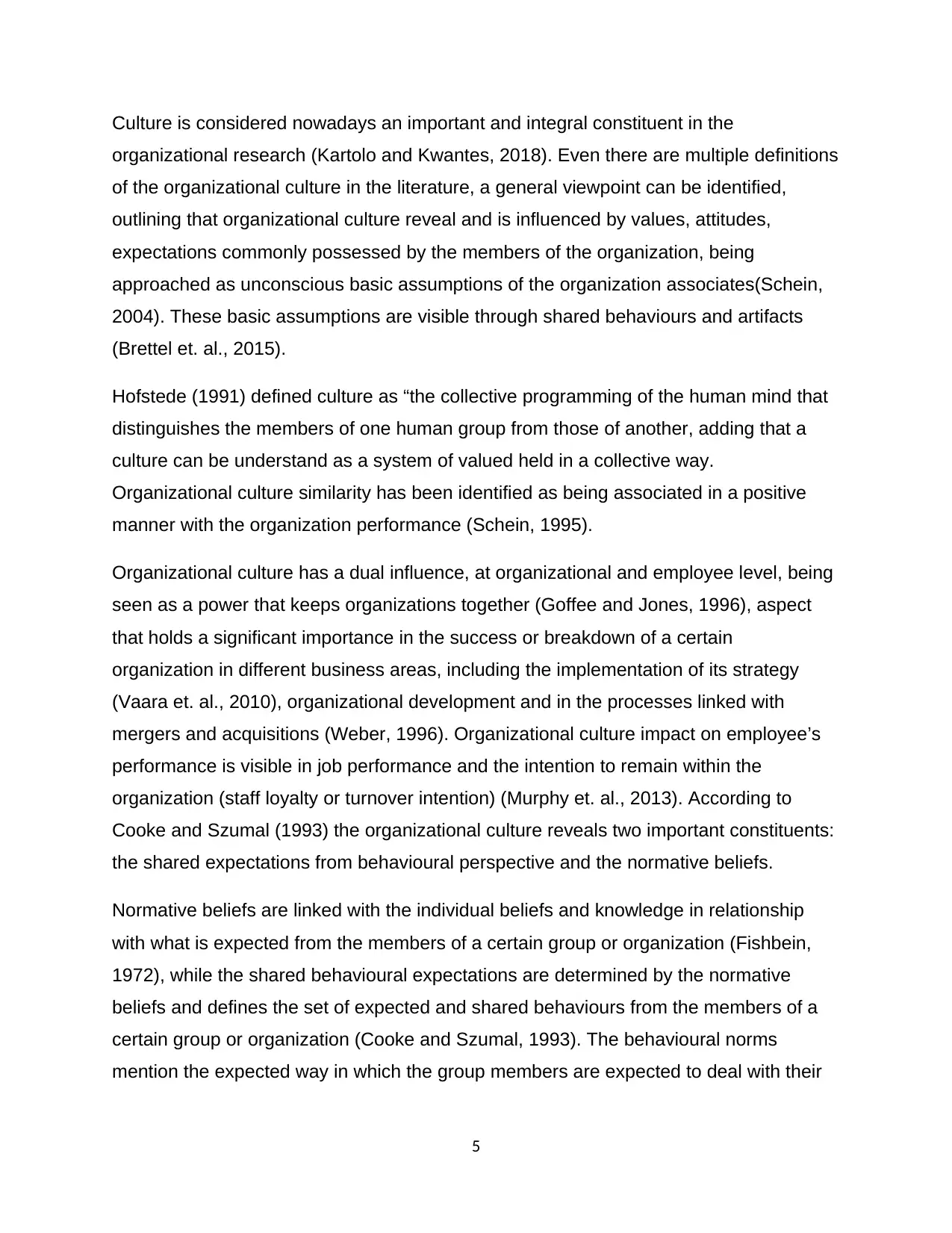
Culture is considered nowadays an important and integral constituent in the
organizational research (Kartolo and Kwantes, 2018). Even there are multiple definitions
of the organizational culture in the literature, a general viewpoint can be identified,
outlining that organizational culture reveal and is influenced by values, attitudes,
expectations commonly possessed by the members of the organization, being
approached as unconscious basic assumptions of the organization associates(Schein,
2004). These basic assumptions are visible through shared behaviours and artifacts
(Brettel et. al., 2015).
Hofstede (1991) defined culture as “the collective programming of the human mind that
distinguishes the members of one human group from those of another, adding that a
culture can be understand as a system of valued held in a collective way.
Organizational culture similarity has been identified as being associated in a positive
manner with the organization performance (Schein, 1995).
Organizational culture has a dual influence, at organizational and employee level, being
seen as a power that keeps organizations together (Goffee and Jones, 1996), aspect
that holds a significant importance in the success or breakdown of a certain
organization in different business areas, including the implementation of its strategy
(Vaara et. al., 2010), organizational development and in the processes linked with
mergers and acquisitions (Weber, 1996). Organizational culture impact on employee’s
performance is visible in job performance and the intention to remain within the
organization (staff loyalty or turnover intention) (Murphy et. al., 2013). According to
Cooke and Szumal (1993) the organizational culture reveals two important constituents:
the shared expectations from behavioural perspective and the normative beliefs.
Normative beliefs are linked with the individual beliefs and knowledge in relationship
with what is expected from the members of a certain group or organization (Fishbein,
1972), while the shared behavioural expectations are determined by the normative
beliefs and defines the set of expected and shared behaviours from the members of a
certain group or organization (Cooke and Szumal, 1993). The behavioural norms
mention the expected way in which the group members are expected to deal with their
5
organizational research (Kartolo and Kwantes, 2018). Even there are multiple definitions
of the organizational culture in the literature, a general viewpoint can be identified,
outlining that organizational culture reveal and is influenced by values, attitudes,
expectations commonly possessed by the members of the organization, being
approached as unconscious basic assumptions of the organization associates(Schein,
2004). These basic assumptions are visible through shared behaviours and artifacts
(Brettel et. al., 2015).
Hofstede (1991) defined culture as “the collective programming of the human mind that
distinguishes the members of one human group from those of another, adding that a
culture can be understand as a system of valued held in a collective way.
Organizational culture similarity has been identified as being associated in a positive
manner with the organization performance (Schein, 1995).
Organizational culture has a dual influence, at organizational and employee level, being
seen as a power that keeps organizations together (Goffee and Jones, 1996), aspect
that holds a significant importance in the success or breakdown of a certain
organization in different business areas, including the implementation of its strategy
(Vaara et. al., 2010), organizational development and in the processes linked with
mergers and acquisitions (Weber, 1996). Organizational culture impact on employee’s
performance is visible in job performance and the intention to remain within the
organization (staff loyalty or turnover intention) (Murphy et. al., 2013). According to
Cooke and Szumal (1993) the organizational culture reveals two important constituents:
the shared expectations from behavioural perspective and the normative beliefs.
Normative beliefs are linked with the individual beliefs and knowledge in relationship
with what is expected from the members of a certain group or organization (Fishbein,
1972), while the shared behavioural expectations are determined by the normative
beliefs and defines the set of expected and shared behaviours from the members of a
certain group or organization (Cooke and Szumal, 1993). The behavioural norms
mention the expected way in which the group members are expected to deal with their
5
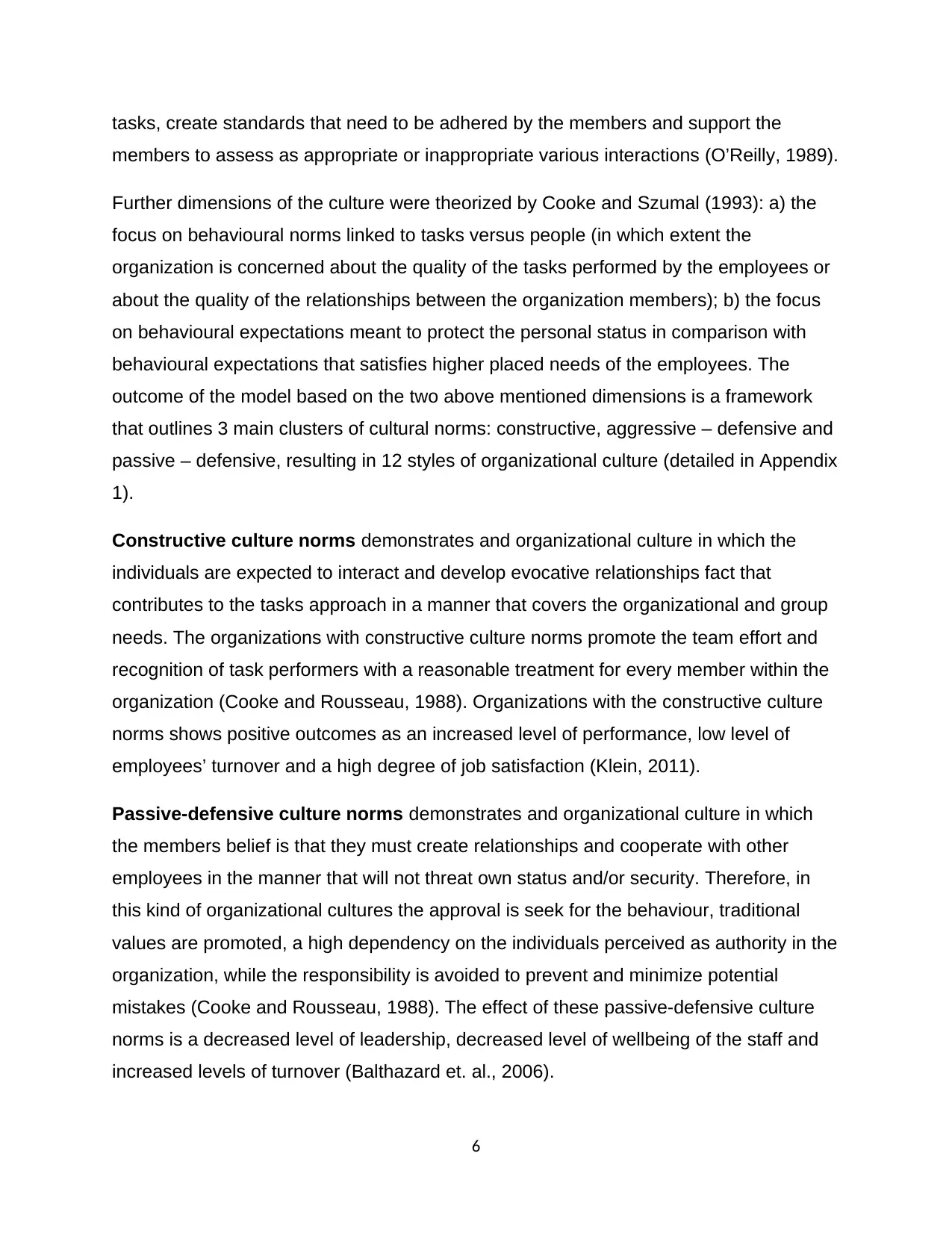
tasks, create standards that need to be adhered by the members and support the
members to assess as appropriate or inappropriate various interactions (O’Reilly, 1989).
Further dimensions of the culture were theorized by Cooke and Szumal (1993): a) the
focus on behavioural norms linked to tasks versus people (in which extent the
organization is concerned about the quality of the tasks performed by the employees or
about the quality of the relationships between the organization members); b) the focus
on behavioural expectations meant to protect the personal status in comparison with
behavioural expectations that satisfies higher placed needs of the employees. The
outcome of the model based on the two above mentioned dimensions is a framework
that outlines 3 main clusters of cultural norms: constructive, aggressive – defensive and
passive – defensive, resulting in 12 styles of organizational culture (detailed in Appendix
1).
Constructive culture norms demonstrates and organizational culture in which the
individuals are expected to interact and develop evocative relationships fact that
contributes to the tasks approach in a manner that covers the organizational and group
needs. The organizations with constructive culture norms promote the team effort and
recognition of task performers with a reasonable treatment for every member within the
organization (Cooke and Rousseau, 1988). Organizations with the constructive culture
norms shows positive outcomes as an increased level of performance, low level of
employees’ turnover and a high degree of job satisfaction (Klein, 2011).
Passive-defensive culture norms demonstrates and organizational culture in which
the members belief is that they must create relationships and cooperate with other
employees in the manner that will not threat own status and/or security. Therefore, in
this kind of organizational cultures the approval is seek for the behaviour, traditional
values are promoted, a high dependency on the individuals perceived as authority in the
organization, while the responsibility is avoided to prevent and minimize potential
mistakes (Cooke and Rousseau, 1988). The effect of these passive-defensive culture
norms is a decreased level of leadership, decreased level of wellbeing of the staff and
increased levels of turnover (Balthazard et. al., 2006).
6
members to assess as appropriate or inappropriate various interactions (O’Reilly, 1989).
Further dimensions of the culture were theorized by Cooke and Szumal (1993): a) the
focus on behavioural norms linked to tasks versus people (in which extent the
organization is concerned about the quality of the tasks performed by the employees or
about the quality of the relationships between the organization members); b) the focus
on behavioural expectations meant to protect the personal status in comparison with
behavioural expectations that satisfies higher placed needs of the employees. The
outcome of the model based on the two above mentioned dimensions is a framework
that outlines 3 main clusters of cultural norms: constructive, aggressive – defensive and
passive – defensive, resulting in 12 styles of organizational culture (detailed in Appendix
1).
Constructive culture norms demonstrates and organizational culture in which the
individuals are expected to interact and develop evocative relationships fact that
contributes to the tasks approach in a manner that covers the organizational and group
needs. The organizations with constructive culture norms promote the team effort and
recognition of task performers with a reasonable treatment for every member within the
organization (Cooke and Rousseau, 1988). Organizations with the constructive culture
norms shows positive outcomes as an increased level of performance, low level of
employees’ turnover and a high degree of job satisfaction (Klein, 2011).
Passive-defensive culture norms demonstrates and organizational culture in which
the members belief is that they must create relationships and cooperate with other
employees in the manner that will not threat own status and/or security. Therefore, in
this kind of organizational cultures the approval is seek for the behaviour, traditional
values are promoted, a high dependency on the individuals perceived as authority in the
organization, while the responsibility is avoided to prevent and minimize potential
mistakes (Cooke and Rousseau, 1988). The effect of these passive-defensive culture
norms is a decreased level of leadership, decreased level of wellbeing of the staff and
increased levels of turnover (Balthazard et. al., 2006).
6
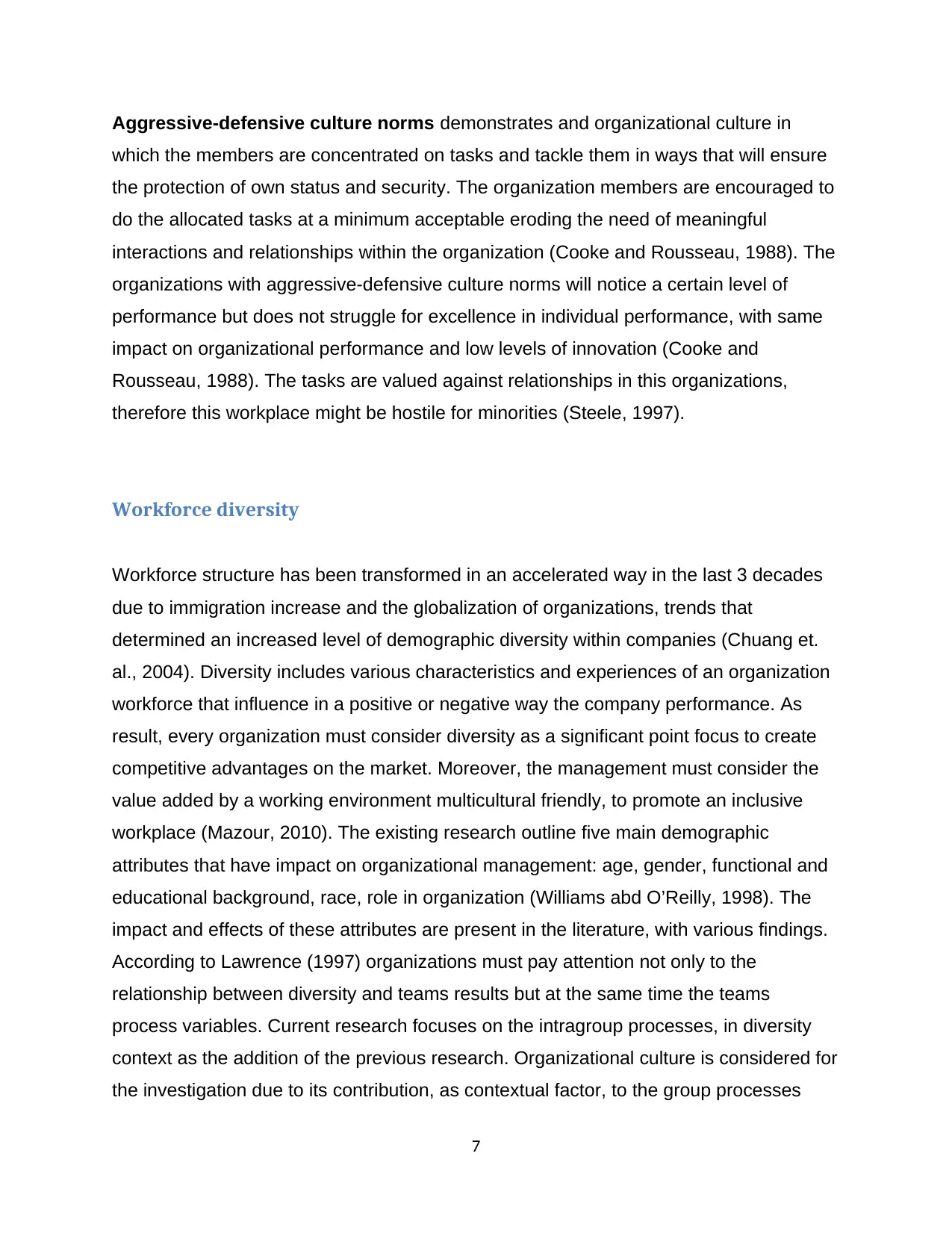
Aggressive-defensive culture norms demonstrates and organizational culture in
which the members are concentrated on tasks and tackle them in ways that will ensure
the protection of own status and security. The organization members are encouraged to
do the allocated tasks at a minimum acceptable eroding the need of meaningful
interactions and relationships within the organization (Cooke and Rousseau, 1988). The
organizations with aggressive-defensive culture norms will notice a certain level of
performance but does not struggle for excellence in individual performance, with same
impact on organizational performance and low levels of innovation (Cooke and
Rousseau, 1988). The tasks are valued against relationships in this organizations,
therefore this workplace might be hostile for minorities (Steele, 1997).
Workforce diversity
Workforce structure has been transformed in an accelerated way in the last 3 decades
due to immigration increase and the globalization of organizations, trends that
determined an increased level of demographic diversity within companies (Chuang et.
al., 2004). Diversity includes various characteristics and experiences of an organization
workforce that influence in a positive or negative way the company performance. As
result, every organization must consider diversity as a significant point focus to create
competitive advantages on the market. Moreover, the management must consider the
value added by a working environment multicultural friendly, to promote an inclusive
workplace (Mazour, 2010). The existing research outline five main demographic
attributes that have impact on organizational management: age, gender, functional and
educational background, race, role in organization (Williams abd O’Reilly, 1998). The
impact and effects of these attributes are present in the literature, with various findings.
According to Lawrence (1997) organizations must pay attention not only to the
relationship between diversity and teams results but at the same time the teams
process variables. Current research focuses on the intragroup processes, in diversity
context as the addition of the previous research. Organizational culture is considered for
the investigation due to its contribution, as contextual factor, to the group processes
7
which the members are concentrated on tasks and tackle them in ways that will ensure
the protection of own status and security. The organization members are encouraged to
do the allocated tasks at a minimum acceptable eroding the need of meaningful
interactions and relationships within the organization (Cooke and Rousseau, 1988). The
organizations with aggressive-defensive culture norms will notice a certain level of
performance but does not struggle for excellence in individual performance, with same
impact on organizational performance and low levels of innovation (Cooke and
Rousseau, 1988). The tasks are valued against relationships in this organizations,
therefore this workplace might be hostile for minorities (Steele, 1997).
Workforce diversity
Workforce structure has been transformed in an accelerated way in the last 3 decades
due to immigration increase and the globalization of organizations, trends that
determined an increased level of demographic diversity within companies (Chuang et.
al., 2004). Diversity includes various characteristics and experiences of an organization
workforce that influence in a positive or negative way the company performance. As
result, every organization must consider diversity as a significant point focus to create
competitive advantages on the market. Moreover, the management must consider the
value added by a working environment multicultural friendly, to promote an inclusive
workplace (Mazour, 2010). The existing research outline five main demographic
attributes that have impact on organizational management: age, gender, functional and
educational background, race, role in organization (Williams abd O’Reilly, 1998). The
impact and effects of these attributes are present in the literature, with various findings.
According to Lawrence (1997) organizations must pay attention not only to the
relationship between diversity and teams results but at the same time the teams
process variables. Current research focuses on the intragroup processes, in diversity
context as the addition of the previous research. Organizational culture is considered for
the investigation due to its contribution, as contextual factor, to the group processes
7
Paraphrase This Document
Need a fresh take? Get an instant paraphrase of this document with our AI Paraphraser
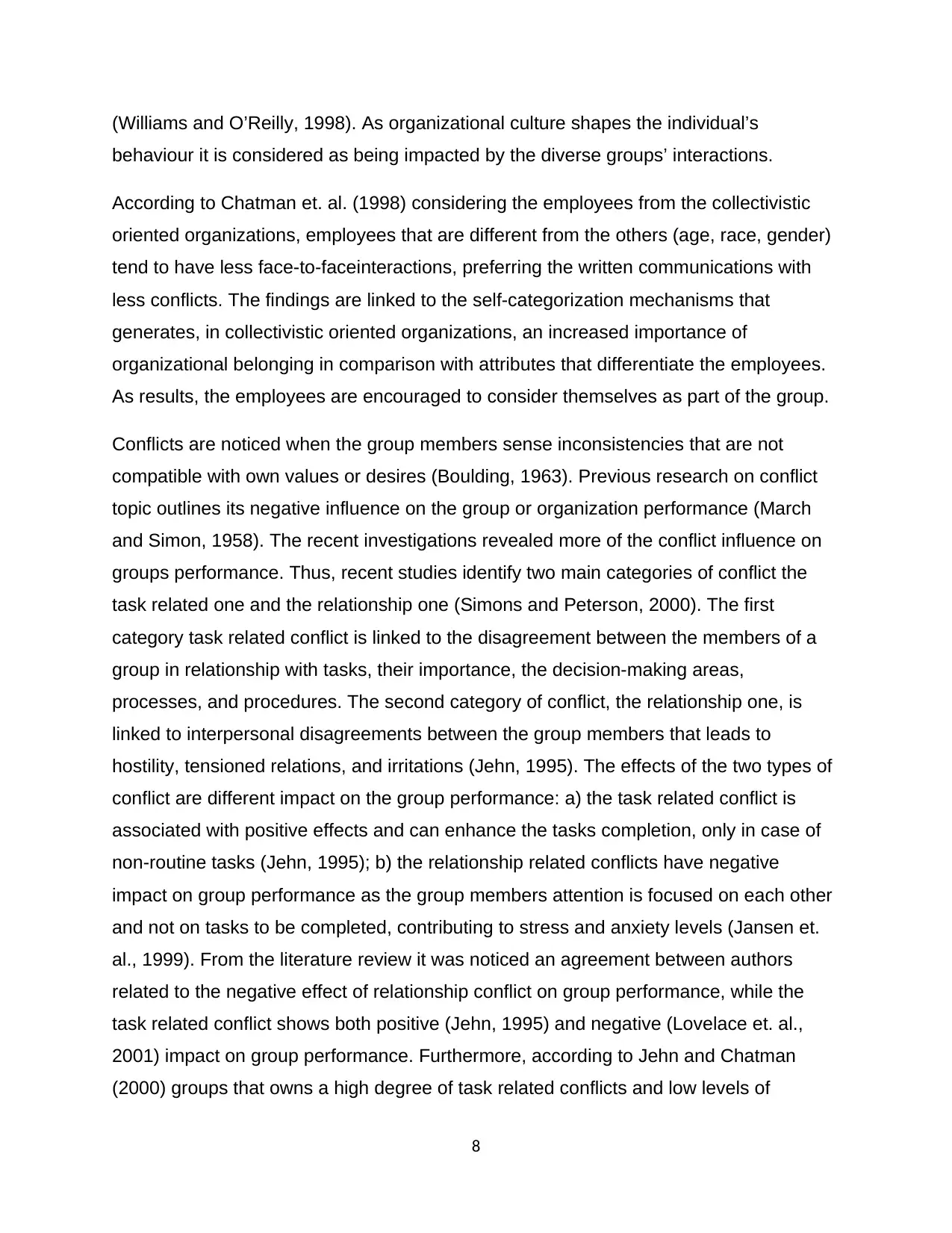
(Williams and O’Reilly, 1998). As organizational culture shapes the individual’s
behaviour it is considered as being impacted by the diverse groups’ interactions.
According to Chatman et. al. (1998) considering the employees from the collectivistic
oriented organizations, employees that are different from the others (age, race, gender)
tend to have less face-to-faceinteractions, preferring the written communications with
less conflicts. The findings are linked to the self-categorization mechanisms that
generates, in collectivistic oriented organizations, an increased importance of
organizational belonging in comparison with attributes that differentiate the employees.
As results, the employees are encouraged to consider themselves as part of the group.
Conflicts are noticed when the group members sense inconsistencies that are not
compatible with own values or desires (Boulding, 1963). Previous research on conflict
topic outlines its negative influence on the group or organization performance (March
and Simon, 1958). The recent investigations revealed more of the conflict influence on
groups performance. Thus, recent studies identify two main categories of conflict the
task related one and the relationship one (Simons and Peterson, 2000). The first
category task related conflict is linked to the disagreement between the members of a
group in relationship with tasks, their importance, the decision-making areas,
processes, and procedures. The second category of conflict, the relationship one, is
linked to interpersonal disagreements between the group members that leads to
hostility, tensioned relations, and irritations (Jehn, 1995). The effects of the two types of
conflict are different impact on the group performance: a) the task related conflict is
associated with positive effects and can enhance the tasks completion, only in case of
non-routine tasks (Jehn, 1995); b) the relationship related conflicts have negative
impact on group performance as the group members attention is focused on each other
and not on tasks to be completed, contributing to stress and anxiety levels (Jansen et.
al., 1999). From the literature review it was noticed an agreement between authors
related to the negative effect of relationship conflict on group performance, while the
task related conflict shows both positive (Jehn, 1995) and negative (Lovelace et. al.,
2001) impact on group performance. Furthermore, according to Jehn and Chatman
(2000) groups that owns a high degree of task related conflicts and low levels of
8
behaviour it is considered as being impacted by the diverse groups’ interactions.
According to Chatman et. al. (1998) considering the employees from the collectivistic
oriented organizations, employees that are different from the others (age, race, gender)
tend to have less face-to-faceinteractions, preferring the written communications with
less conflicts. The findings are linked to the self-categorization mechanisms that
generates, in collectivistic oriented organizations, an increased importance of
organizational belonging in comparison with attributes that differentiate the employees.
As results, the employees are encouraged to consider themselves as part of the group.
Conflicts are noticed when the group members sense inconsistencies that are not
compatible with own values or desires (Boulding, 1963). Previous research on conflict
topic outlines its negative influence on the group or organization performance (March
and Simon, 1958). The recent investigations revealed more of the conflict influence on
groups performance. Thus, recent studies identify two main categories of conflict the
task related one and the relationship one (Simons and Peterson, 2000). The first
category task related conflict is linked to the disagreement between the members of a
group in relationship with tasks, their importance, the decision-making areas,
processes, and procedures. The second category of conflict, the relationship one, is
linked to interpersonal disagreements between the group members that leads to
hostility, tensioned relations, and irritations (Jehn, 1995). The effects of the two types of
conflict are different impact on the group performance: a) the task related conflict is
associated with positive effects and can enhance the tasks completion, only in case of
non-routine tasks (Jehn, 1995); b) the relationship related conflicts have negative
impact on group performance as the group members attention is focused on each other
and not on tasks to be completed, contributing to stress and anxiety levels (Jansen et.
al., 1999). From the literature review it was noticed an agreement between authors
related to the negative effect of relationship conflict on group performance, while the
task related conflict shows both positive (Jehn, 1995) and negative (Lovelace et. al.,
2001) impact on group performance. Furthermore, according to Jehn and Chatman
(2000) groups that owns a high degree of task related conflicts and low levels of
8
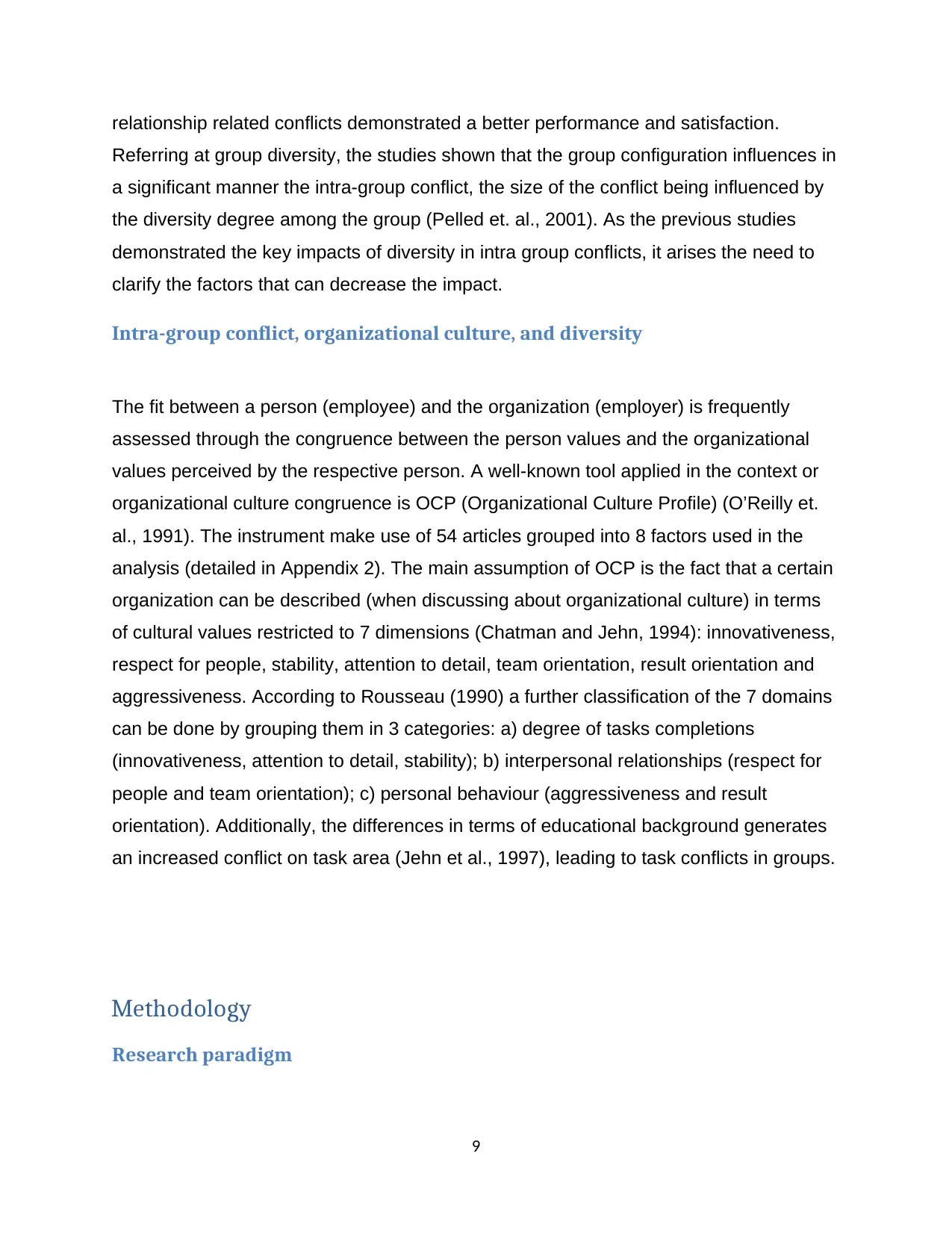
relationship related conflicts demonstrated a better performance and satisfaction.
Referring at group diversity, the studies shown that the group configuration influences in
a significant manner the intra-group conflict, the size of the conflict being influenced by
the diversity degree among the group (Pelled et. al., 2001). As the previous studies
demonstrated the key impacts of diversity in intra group conflicts, it arises the need to
clarify the factors that can decrease the impact.
Intra-group conflict, organizational culture, and diversity
The fit between a person (employee) and the organization (employer) is frequently
assessed through the congruence between the person values and the organizational
values perceived by the respective person. A well-known tool applied in the context or
organizational culture congruence is OCP (Organizational Culture Profile) (O’Reilly et.
al., 1991). The instrument make use of 54 articles grouped into 8 factors used in the
analysis (detailed in Appendix 2). The main assumption of OCP is the fact that a certain
organization can be described (when discussing about organizational culture) in terms
of cultural values restricted to 7 dimensions (Chatman and Jehn, 1994): innovativeness,
respect for people, stability, attention to detail, team orientation, result orientation and
aggressiveness. According to Rousseau (1990) a further classification of the 7 domains
can be done by grouping them in 3 categories: a) degree of tasks completions
(innovativeness, attention to detail, stability); b) interpersonal relationships (respect for
people and team orientation); c) personal behaviour (aggressiveness and result
orientation). Additionally, the differences in terms of educational background generates
an increased conflict on task area (Jehn et al., 1997), leading to task conflicts in groups.
Methodology
Research paradigm
9
Referring at group diversity, the studies shown that the group configuration influences in
a significant manner the intra-group conflict, the size of the conflict being influenced by
the diversity degree among the group (Pelled et. al., 2001). As the previous studies
demonstrated the key impacts of diversity in intra group conflicts, it arises the need to
clarify the factors that can decrease the impact.
Intra-group conflict, organizational culture, and diversity
The fit between a person (employee) and the organization (employer) is frequently
assessed through the congruence between the person values and the organizational
values perceived by the respective person. A well-known tool applied in the context or
organizational culture congruence is OCP (Organizational Culture Profile) (O’Reilly et.
al., 1991). The instrument make use of 54 articles grouped into 8 factors used in the
analysis (detailed in Appendix 2). The main assumption of OCP is the fact that a certain
organization can be described (when discussing about organizational culture) in terms
of cultural values restricted to 7 dimensions (Chatman and Jehn, 1994): innovativeness,
respect for people, stability, attention to detail, team orientation, result orientation and
aggressiveness. According to Rousseau (1990) a further classification of the 7 domains
can be done by grouping them in 3 categories: a) degree of tasks completions
(innovativeness, attention to detail, stability); b) interpersonal relationships (respect for
people and team orientation); c) personal behaviour (aggressiveness and result
orientation). Additionally, the differences in terms of educational background generates
an increased conflict on task area (Jehn et al., 1997), leading to task conflicts in groups.
Methodology
Research paradigm
9
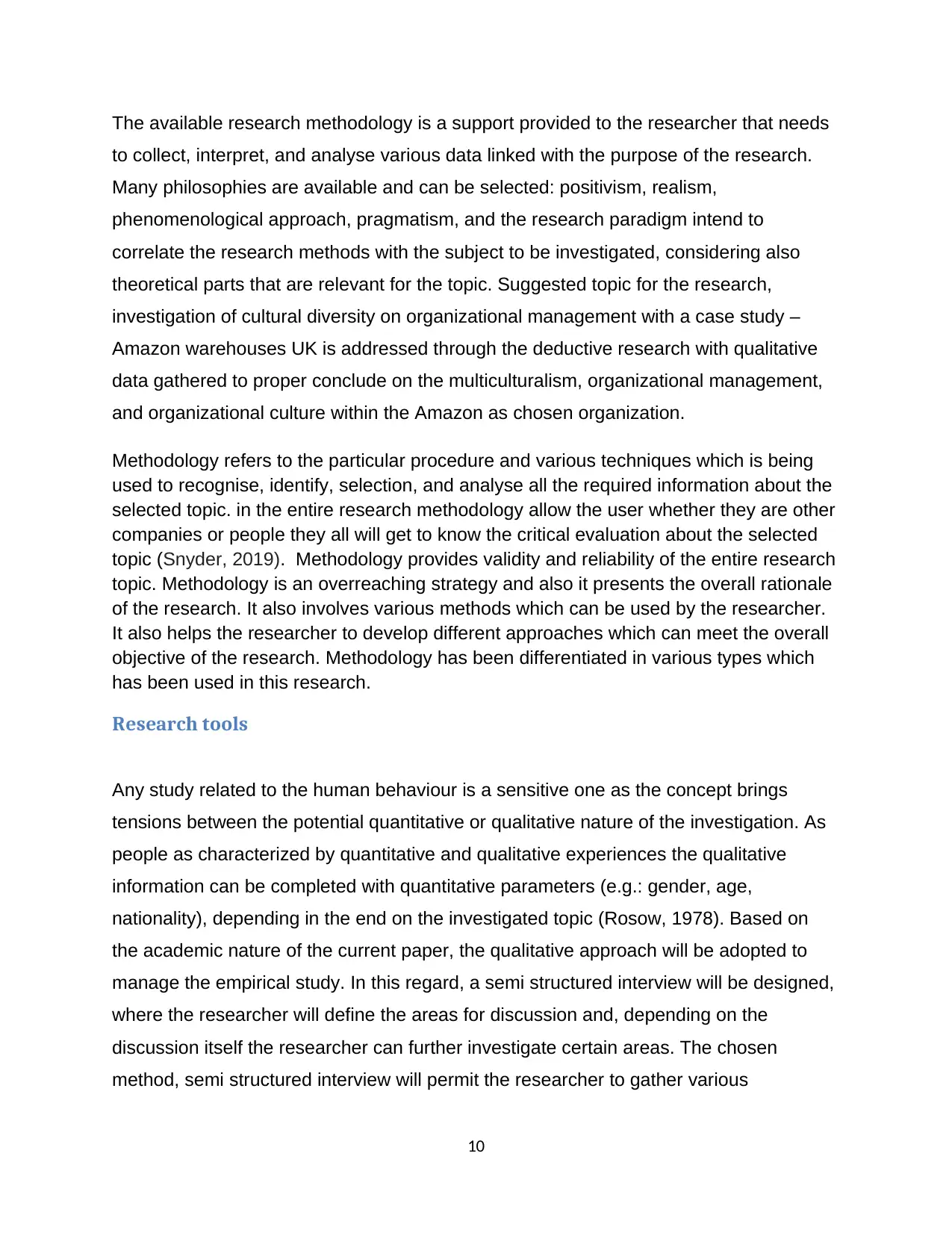
The available research methodology is a support provided to the researcher that needs
to collect, interpret, and analyse various data linked with the purpose of the research.
Many philosophies are available and can be selected: positivism, realism,
phenomenological approach, pragmatism, and the research paradigm intend to
correlate the research methods with the subject to be investigated, considering also
theoretical parts that are relevant for the topic. Suggested topic for the research,
investigation of cultural diversity on organizational management with a case study –
Amazon warehouses UK is addressed through the deductive research with qualitative
data gathered to proper conclude on the multiculturalism, organizational management,
and organizational culture within the Amazon as chosen organization.
Methodology refers to the particular procedure and various techniques which is being
used to recognise, identify, selection, and analyse all the required information about the
selected topic. in the entire research methodology allow the user whether they are other
companies or people they all will get to know the critical evaluation about the selected
topic (Snyder, 2019). Methodology provides validity and reliability of the entire research
topic. Methodology is an overreaching strategy and also it presents the overall rationale
of the research. It also involves various methods which can be used by the researcher.
It also helps the researcher to develop different approaches which can meet the overall
objective of the research. Methodology has been differentiated in various types which
has been used in this research.
Research tools
Any study related to the human behaviour is a sensitive one as the concept brings
tensions between the potential quantitative or qualitative nature of the investigation. As
people as characterized by quantitative and qualitative experiences the qualitative
information can be completed with quantitative parameters (e.g.: gender, age,
nationality), depending in the end on the investigated topic (Rosow, 1978). Based on
the academic nature of the current paper, the qualitative approach will be adopted to
manage the empirical study. In this regard, a semi structured interview will be designed,
where the researcher will define the areas for discussion and, depending on the
discussion itself the researcher can further investigate certain areas. The chosen
method, semi structured interview will permit the researcher to gather various
10
to collect, interpret, and analyse various data linked with the purpose of the research.
Many philosophies are available and can be selected: positivism, realism,
phenomenological approach, pragmatism, and the research paradigm intend to
correlate the research methods with the subject to be investigated, considering also
theoretical parts that are relevant for the topic. Suggested topic for the research,
investigation of cultural diversity on organizational management with a case study –
Amazon warehouses UK is addressed through the deductive research with qualitative
data gathered to proper conclude on the multiculturalism, organizational management,
and organizational culture within the Amazon as chosen organization.
Methodology refers to the particular procedure and various techniques which is being
used to recognise, identify, selection, and analyse all the required information about the
selected topic. in the entire research methodology allow the user whether they are other
companies or people they all will get to know the critical evaluation about the selected
topic (Snyder, 2019). Methodology provides validity and reliability of the entire research
topic. Methodology is an overreaching strategy and also it presents the overall rationale
of the research. It also involves various methods which can be used by the researcher.
It also helps the researcher to develop different approaches which can meet the overall
objective of the research. Methodology has been differentiated in various types which
has been used in this research.
Research tools
Any study related to the human behaviour is a sensitive one as the concept brings
tensions between the potential quantitative or qualitative nature of the investigation. As
people as characterized by quantitative and qualitative experiences the qualitative
information can be completed with quantitative parameters (e.g.: gender, age,
nationality), depending in the end on the investigated topic (Rosow, 1978). Based on
the academic nature of the current paper, the qualitative approach will be adopted to
manage the empirical study. In this regard, a semi structured interview will be designed,
where the researcher will define the areas for discussion and, depending on the
discussion itself the researcher can further investigate certain areas. The chosen
method, semi structured interview will permit the researcher to gather various
10
Secure Best Marks with AI Grader
Need help grading? Try our AI Grader for instant feedback on your assignments.
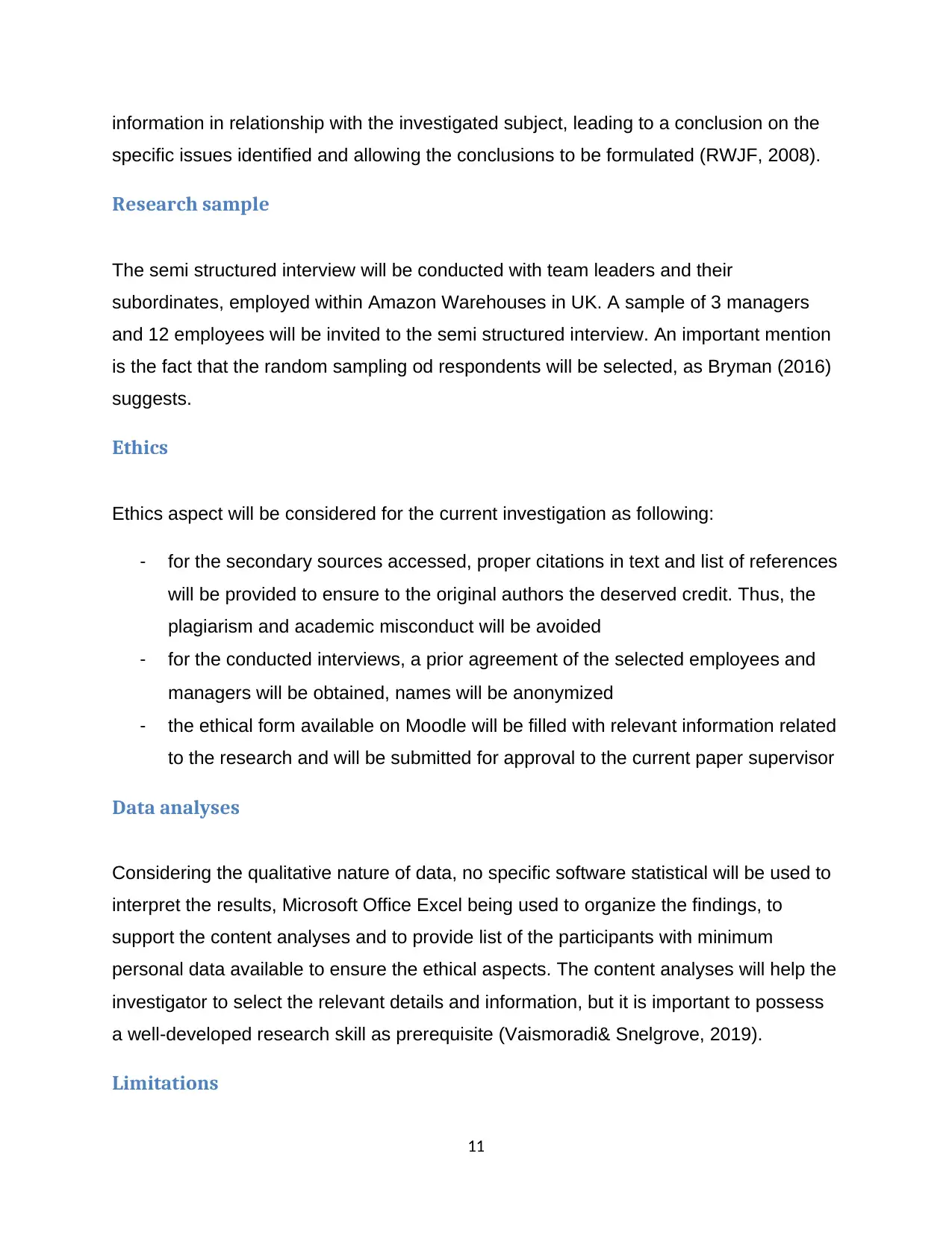
information in relationship with the investigated subject, leading to a conclusion on the
specific issues identified and allowing the conclusions to be formulated (RWJF, 2008).
Research sample
The semi structured interview will be conducted with team leaders and their
subordinates, employed within Amazon Warehouses in UK. A sample of 3 managers
and 12 employees will be invited to the semi structured interview. An important mention
is the fact that the random sampling od respondents will be selected, as Bryman (2016)
suggests.
Ethics
Ethics aspect will be considered for the current investigation as following:
- for the secondary sources accessed, proper citations in text and list of references
will be provided to ensure to the original authors the deserved credit. Thus, the
plagiarism and academic misconduct will be avoided
- for the conducted interviews, a prior agreement of the selected employees and
managers will be obtained, names will be anonymized
- the ethical form available on Moodle will be filled with relevant information related
to the research and will be submitted for approval to the current paper supervisor
Data analyses
Considering the qualitative nature of data, no specific software statistical will be used to
interpret the results, Microsoft Office Excel being used to organize the findings, to
support the content analyses and to provide list of the participants with minimum
personal data available to ensure the ethical aspects. The content analyses will help the
investigator to select the relevant details and information, but it is important to possess
a well-developed research skill as prerequisite (Vaismoradi& Snelgrove, 2019).
Limitations
11
specific issues identified and allowing the conclusions to be formulated (RWJF, 2008).
Research sample
The semi structured interview will be conducted with team leaders and their
subordinates, employed within Amazon Warehouses in UK. A sample of 3 managers
and 12 employees will be invited to the semi structured interview. An important mention
is the fact that the random sampling od respondents will be selected, as Bryman (2016)
suggests.
Ethics
Ethics aspect will be considered for the current investigation as following:
- for the secondary sources accessed, proper citations in text and list of references
will be provided to ensure to the original authors the deserved credit. Thus, the
plagiarism and academic misconduct will be avoided
- for the conducted interviews, a prior agreement of the selected employees and
managers will be obtained, names will be anonymized
- the ethical form available on Moodle will be filled with relevant information related
to the research and will be submitted for approval to the current paper supervisor
Data analyses
Considering the qualitative nature of data, no specific software statistical will be used to
interpret the results, Microsoft Office Excel being used to organize the findings, to
support the content analyses and to provide list of the participants with minimum
personal data available to ensure the ethical aspects. The content analyses will help the
investigator to select the relevant details and information, but it is important to possess
a well-developed research skill as prerequisite (Vaismoradi& Snelgrove, 2019).
Limitations
11
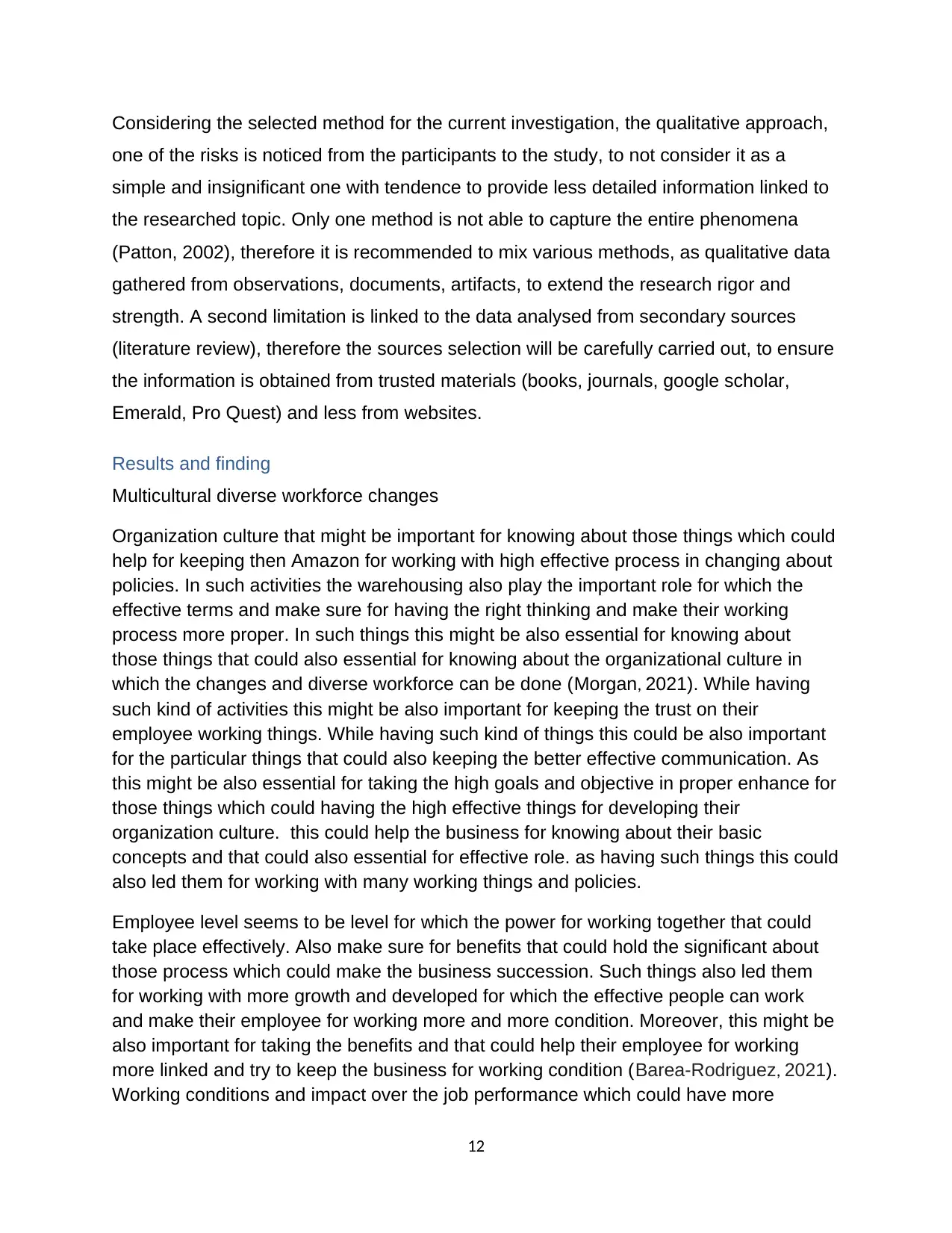
Considering the selected method for the current investigation, the qualitative approach,
one of the risks is noticed from the participants to the study, to not consider it as a
simple and insignificant one with tendence to provide less detailed information linked to
the researched topic. Only one method is not able to capture the entire phenomena
(Patton, 2002), therefore it is recommended to mix various methods, as qualitative data
gathered from observations, documents, artifacts, to extend the research rigor and
strength. A second limitation is linked to the data analysed from secondary sources
(literature review), therefore the sources selection will be carefully carried out, to ensure
the information is obtained from trusted materials (books, journals, google scholar,
Emerald, Pro Quest) and less from websites.
Results and finding
Multicultural diverse workforce changes
Organization culture that might be important for knowing about those things which could
help for keeping then Amazon for working with high effective process in changing about
policies. In such activities the warehousing also play the important role for which the
effective terms and make sure for having the right thinking and make their working
process more proper. In such things this might be also essential for knowing about
those things that could also essential for knowing about the organizational culture in
which the changes and diverse workforce can be done (Morgan, 2021). While having
such kind of activities this might be also important for keeping the trust on their
employee working things. While having such kind of things this could be also important
for the particular things that could also keeping the better effective communication. As
this might be also essential for taking the high goals and objective in proper enhance for
those things which could having the high effective things for developing their
organization culture. this could help the business for knowing about their basic
concepts and that could also essential for effective role. as having such things this could
also led them for working with many working things and policies.
Employee level seems to be level for which the power for working together that could
take place effectively. Also make sure for benefits that could hold the significant about
those process which could make the business succession. Such things also led them
for working with more growth and developed for which the effective people can work
and make their employee for working more and more condition. Moreover, this might be
also important for taking the benefits and that could help their employee for working
more linked and try to keep the business for working condition (Barea-Rodriguez, 2021).
Working conditions and impact over the job performance which could have more
12
one of the risks is noticed from the participants to the study, to not consider it as a
simple and insignificant one with tendence to provide less detailed information linked to
the researched topic. Only one method is not able to capture the entire phenomena
(Patton, 2002), therefore it is recommended to mix various methods, as qualitative data
gathered from observations, documents, artifacts, to extend the research rigor and
strength. A second limitation is linked to the data analysed from secondary sources
(literature review), therefore the sources selection will be carefully carried out, to ensure
the information is obtained from trusted materials (books, journals, google scholar,
Emerald, Pro Quest) and less from websites.
Results and finding
Multicultural diverse workforce changes
Organization culture that might be important for knowing about those things which could
help for keeping then Amazon for working with high effective process in changing about
policies. In such activities the warehousing also play the important role for which the
effective terms and make sure for having the right thinking and make their working
process more proper. In such things this might be also essential for knowing about
those things that could also essential for knowing about the organizational culture in
which the changes and diverse workforce can be done (Morgan, 2021). While having
such kind of activities this might be also important for keeping the trust on their
employee working things. While having such kind of things this could be also important
for the particular things that could also keeping the better effective communication. As
this might be also essential for taking the high goals and objective in proper enhance for
those things which could having the high effective things for developing their
organization culture. this could help the business for knowing about their basic
concepts and that could also essential for effective role. as having such things this could
also led them for working with many working things and policies.
Employee level seems to be level for which the power for working together that could
take place effectively. Also make sure for benefits that could hold the significant about
those process which could make the business succession. Such things also led them
for working with more growth and developed for which the effective people can work
and make their employee for working more and more condition. Moreover, this might be
also important for taking the benefits and that could help their employee for working
more linked and try to keep the business for working condition (Barea-Rodriguez, 2021).
Working conditions and impact over the job performance which could have more
12
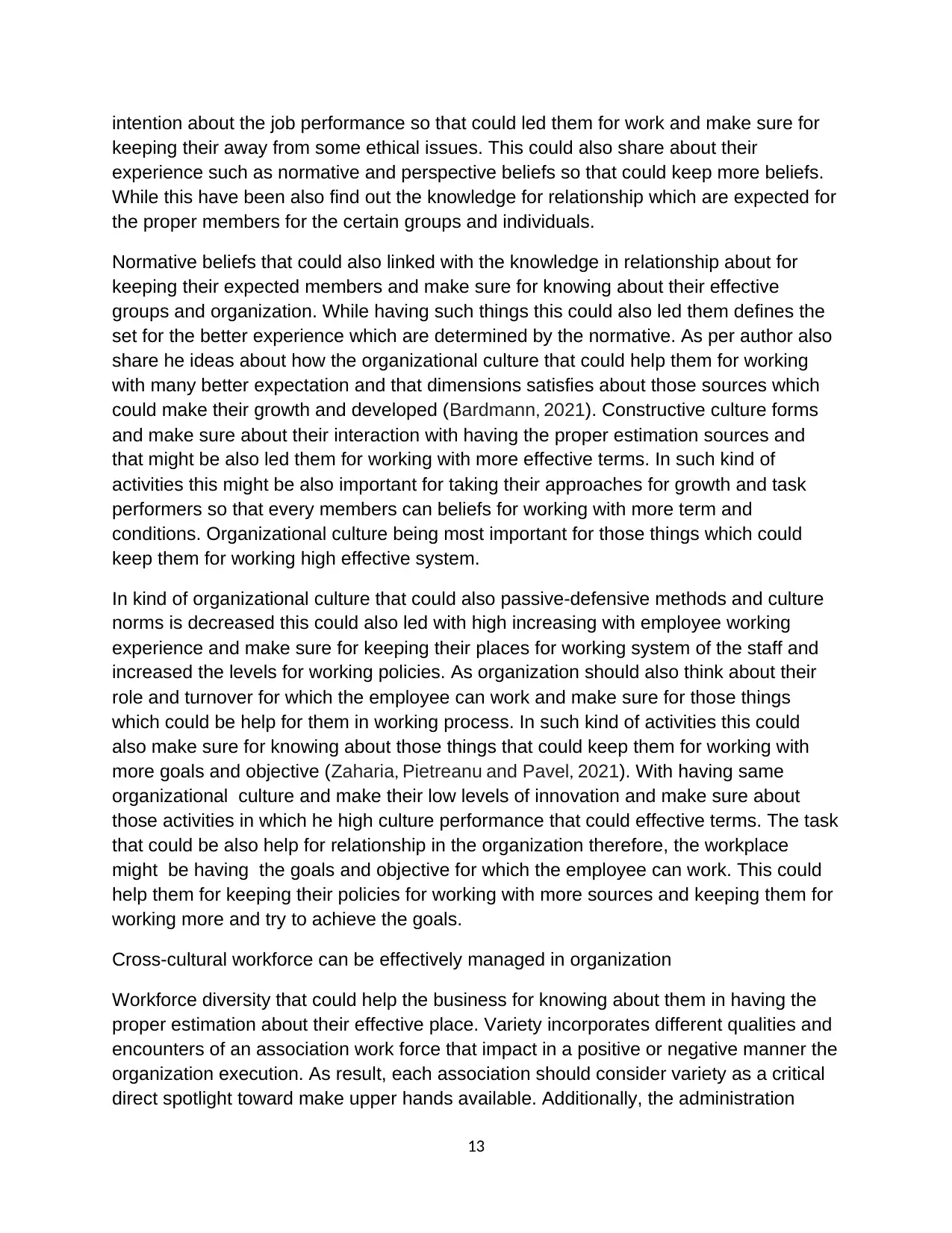
intention about the job performance so that could led them for work and make sure for
keeping their away from some ethical issues. This could also share about their
experience such as normative and perspective beliefs so that could keep more beliefs.
While this have been also find out the knowledge for relationship which are expected for
the proper members for the certain groups and individuals.
Normative beliefs that could also linked with the knowledge in relationship about for
keeping their expected members and make sure for knowing about their effective
groups and organization. While having such things this could also led them defines the
set for the better experience which are determined by the normative. As per author also
share he ideas about how the organizational culture that could help them for working
with many better expectation and that dimensions satisfies about those sources which
could make their growth and developed (Bardmann, 2021). Constructive culture forms
and make sure about their interaction with having the proper estimation sources and
that might be also led them for working with more effective terms. In such kind of
activities this might be also important for taking their approaches for growth and task
performers so that every members can beliefs for working with more term and
conditions. Organizational culture being most important for those things which could
keep them for working high effective system.
In kind of organizational culture that could also passive-defensive methods and culture
norms is decreased this could also led with high increasing with employee working
experience and make sure for keeping their places for working system of the staff and
increased the levels for working policies. As organization should also think about their
role and turnover for which the employee can work and make sure for those things
which could be help for them in working process. In such kind of activities this could
also make sure for knowing about those things that could keep them for working with
more goals and objective (Zaharia, Pietreanu and Pavel, 2021). With having same
organizational culture and make their low levels of innovation and make sure about
those activities in which he high culture performance that could effective terms. The task
that could be also help for relationship in the organization therefore, the workplace
might be having the goals and objective for which the employee can work. This could
help them for keeping their policies for working with more sources and keeping them for
working more and try to achieve the goals.
Cross-cultural workforce can be effectively managed in organization
Workforce diversity that could help the business for knowing about them in having the
proper estimation about their effective place. Variety incorporates different qualities and
encounters of an association work force that impact in a positive or negative manner the
organization execution. As result, each association should consider variety as a critical
direct spotlight toward make upper hands available. Additionally, the administration
13
keeping their away from some ethical issues. This could also share about their
experience such as normative and perspective beliefs so that could keep more beliefs.
While this have been also find out the knowledge for relationship which are expected for
the proper members for the certain groups and individuals.
Normative beliefs that could also linked with the knowledge in relationship about for
keeping their expected members and make sure for knowing about their effective
groups and organization. While having such things this could also led them defines the
set for the better experience which are determined by the normative. As per author also
share he ideas about how the organizational culture that could help them for working
with many better expectation and that dimensions satisfies about those sources which
could make their growth and developed (Bardmann, 2021). Constructive culture forms
and make sure about their interaction with having the proper estimation sources and
that might be also led them for working with more effective terms. In such kind of
activities this might be also important for taking their approaches for growth and task
performers so that every members can beliefs for working with more term and
conditions. Organizational culture being most important for those things which could
keep them for working high effective system.
In kind of organizational culture that could also passive-defensive methods and culture
norms is decreased this could also led with high increasing with employee working
experience and make sure for keeping their places for working system of the staff and
increased the levels for working policies. As organization should also think about their
role and turnover for which the employee can work and make sure for those things
which could be help for them in working process. In such kind of activities this could
also make sure for knowing about those things that could keep them for working with
more goals and objective (Zaharia, Pietreanu and Pavel, 2021). With having same
organizational culture and make their low levels of innovation and make sure about
those activities in which he high culture performance that could effective terms. The task
that could be also help for relationship in the organization therefore, the workplace
might be having the goals and objective for which the employee can work. This could
help them for keeping their policies for working with more sources and keeping them for
working more and try to achieve the goals.
Cross-cultural workforce can be effectively managed in organization
Workforce diversity that could help the business for knowing about them in having the
proper estimation about their effective place. Variety incorporates different qualities and
encounters of an association work force that impact in a positive or negative manner the
organization execution. As result, each association should consider variety as a critical
direct spotlight toward make upper hands available. Additionally, the administration
13
Paraphrase This Document
Need a fresh take? Get an instant paraphrase of this document with our AI Paraphraser
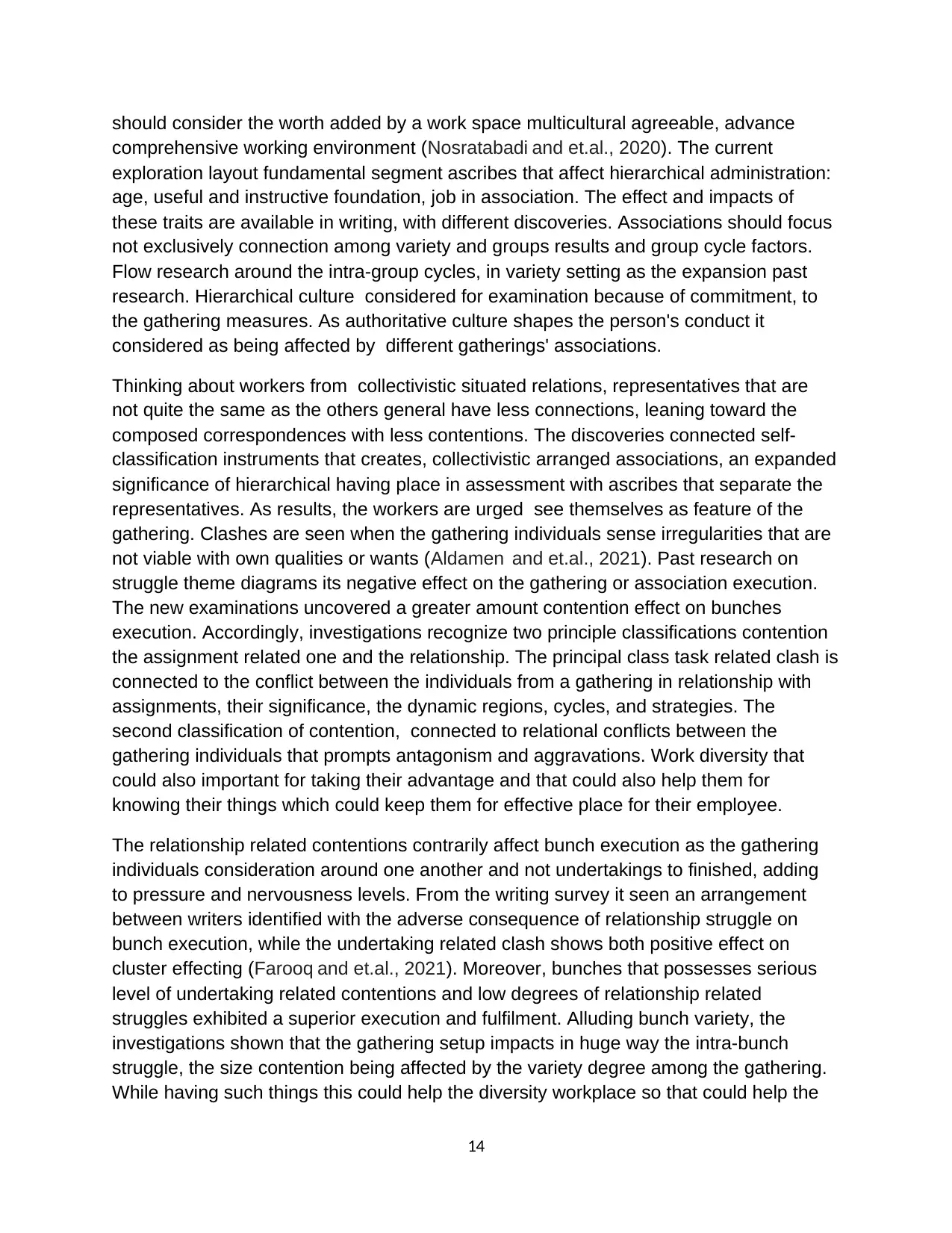
should consider the worth added by a work space multicultural agreeable, advance
comprehensive working environment (Nosratabadi and et.al., 2020). The current
exploration layout fundamental segment ascribes that affect hierarchical administration:
age, useful and instructive foundation, job in association. The effect and impacts of
these traits are available in writing, with different discoveries. Associations should focus
not exclusively connection among variety and groups results and group cycle factors.
Flow research around the intra-group cycles, in variety setting as the expansion past
research. Hierarchical culture considered for examination because of commitment, to
the gathering measures. As authoritative culture shapes the person's conduct it
considered as being affected by different gatherings' associations.
Thinking about workers from collectivistic situated relations, representatives that are
not quite the same as the others general have less connections, leaning toward the
composed correspondences with less contentions. The discoveries connected self-
classification instruments that creates, collectivistic arranged associations, an expanded
significance of hierarchical having place in assessment with ascribes that separate the
representatives. As results, the workers are urged see themselves as feature of the
gathering. Clashes are seen when the gathering individuals sense irregularities that are
not viable with own qualities or wants (Aldamen and et.al., 2021). Past research on
struggle theme diagrams its negative effect on the gathering or association execution.
The new examinations uncovered a greater amount contention effect on bunches
execution. Accordingly, investigations recognize two principle classifications contention
the assignment related one and the relationship. The principal class task related clash is
connected to the conflict between the individuals from a gathering in relationship with
assignments, their significance, the dynamic regions, cycles, and strategies. The
second classification of contention, connected to relational conflicts between the
gathering individuals that prompts antagonism and aggravations. Work diversity that
could also important for taking their advantage and that could also help them for
knowing their things which could keep them for effective place for their employee.
The relationship related contentions contrarily affect bunch execution as the gathering
individuals consideration around one another and not undertakings to finished, adding
to pressure and nervousness levels. From the writing survey it seen an arrangement
between writers identified with the adverse consequence of relationship struggle on
bunch execution, while the undertaking related clash shows both positive effect on
cluster effecting (Farooq and et.al., 2021). Moreover, bunches that possesses serious
level of undertaking related contentions and low degrees of relationship related
struggles exhibited a superior execution and fulfilment. Alluding bunch variety, the
investigations shown that the gathering setup impacts in huge way the intra-bunch
struggle, the size contention being affected by the variety degree among the gathering.
While having such things this could help the diversity workplace so that could help the
14
comprehensive working environment (Nosratabadi and et.al., 2020). The current
exploration layout fundamental segment ascribes that affect hierarchical administration:
age, useful and instructive foundation, job in association. The effect and impacts of
these traits are available in writing, with different discoveries. Associations should focus
not exclusively connection among variety and groups results and group cycle factors.
Flow research around the intra-group cycles, in variety setting as the expansion past
research. Hierarchical culture considered for examination because of commitment, to
the gathering measures. As authoritative culture shapes the person's conduct it
considered as being affected by different gatherings' associations.
Thinking about workers from collectivistic situated relations, representatives that are
not quite the same as the others general have less connections, leaning toward the
composed correspondences with less contentions. The discoveries connected self-
classification instruments that creates, collectivistic arranged associations, an expanded
significance of hierarchical having place in assessment with ascribes that separate the
representatives. As results, the workers are urged see themselves as feature of the
gathering. Clashes are seen when the gathering individuals sense irregularities that are
not viable with own qualities or wants (Aldamen and et.al., 2021). Past research on
struggle theme diagrams its negative effect on the gathering or association execution.
The new examinations uncovered a greater amount contention effect on bunches
execution. Accordingly, investigations recognize two principle classifications contention
the assignment related one and the relationship. The principal class task related clash is
connected to the conflict between the individuals from a gathering in relationship with
assignments, their significance, the dynamic regions, cycles, and strategies. The
second classification of contention, connected to relational conflicts between the
gathering individuals that prompts antagonism and aggravations. Work diversity that
could also important for taking their advantage and that could also help them for
knowing their things which could keep them for effective place for their employee.
The relationship related contentions contrarily affect bunch execution as the gathering
individuals consideration around one another and not undertakings to finished, adding
to pressure and nervousness levels. From the writing survey it seen an arrangement
between writers identified with the adverse consequence of relationship struggle on
bunch execution, while the undertaking related clash shows both positive effect on
cluster effecting (Farooq and et.al., 2021). Moreover, bunches that possesses serious
level of undertaking related contentions and low degrees of relationship related
struggles exhibited a superior execution and fulfilment. Alluding bunch variety, the
investigations shown that the gathering setup impacts in huge way the intra-bunch
struggle, the size contention being affected by the variety degree among the gathering.
While having such things this could help the diversity workplace so that could help the
14
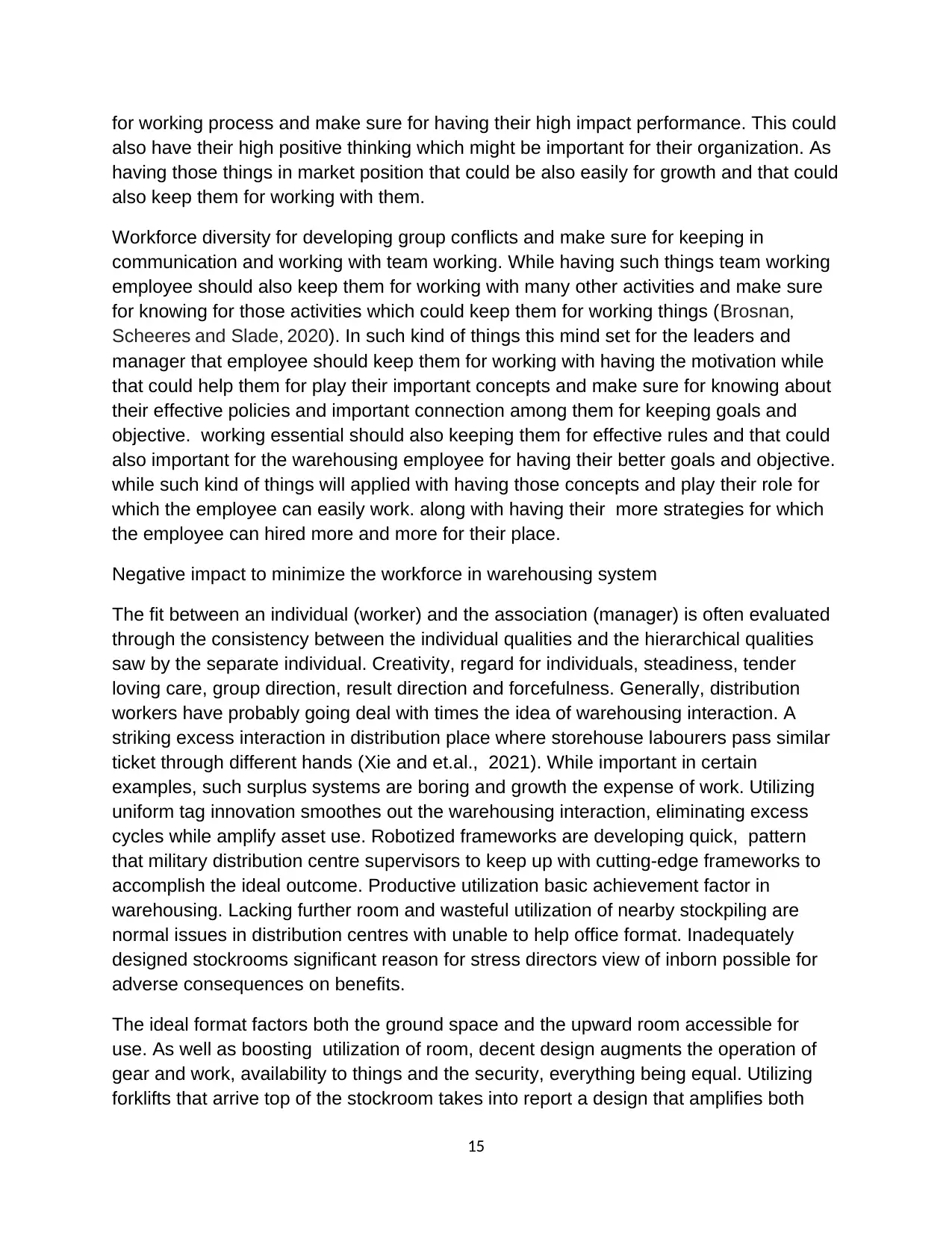
for working process and make sure for having their high impact performance. This could
also have their high positive thinking which might be important for their organization. As
having those things in market position that could be also easily for growth and that could
also keep them for working with them.
Workforce diversity for developing group conflicts and make sure for keeping in
communication and working with team working. While having such things team working
employee should also keep them for working with many other activities and make sure
for knowing for those activities which could keep them for working things (Brosnan,
Scheeres and Slade, 2020). In such kind of things this mind set for the leaders and
manager that employee should keep them for working with having the motivation while
that could help them for play their important concepts and make sure for knowing about
their effective policies and important connection among them for keeping goals and
objective. working essential should also keeping them for effective rules and that could
also important for the warehousing employee for having their better goals and objective.
while such kind of things will applied with having those concepts and play their role for
which the employee can easily work. along with having their more strategies for which
the employee can hired more and more for their place.
Negative impact to minimize the workforce in warehousing system
The fit between an individual (worker) and the association (manager) is often evaluated
through the consistency between the individual qualities and the hierarchical qualities
saw by the separate individual. Creativity, regard for individuals, steadiness, tender
loving care, group direction, result direction and forcefulness. Generally, distribution
workers have probably going deal with times the idea of warehousing interaction. A
striking excess interaction in distribution place where storehouse labourers pass similar
ticket through different hands (Xie and et.al., 2021). While important in certain
examples, such surplus systems are boring and growth the expense of work. Utilizing
uniform tag innovation smoothes out the warehousing interaction, eliminating excess
cycles while amplify asset use. Robotized frameworks are developing quick, pattern
that military distribution centre supervisors to keep up with cutting-edge frameworks to
accomplish the ideal outcome. Productive utilization basic achievement factor in
warehousing. Lacking further room and wasteful utilization of nearby stockpiling are
normal issues in distribution centres with unable to help office format. Inadequately
designed stockrooms significant reason for stress directors view of inborn possible for
adverse consequences on benefits.
The ideal format factors both the ground space and the upward room accessible for
use. As well as boosting utilization of room, decent design augments the operation of
gear and work, availability to things and the security, everything being equal. Utilizing
forklifts that arrive top of the stockroom takes into report a design that amplifies both
15
also have their high positive thinking which might be important for their organization. As
having those things in market position that could be also easily for growth and that could
also keep them for working with them.
Workforce diversity for developing group conflicts and make sure for keeping in
communication and working with team working. While having such things team working
employee should also keep them for working with many other activities and make sure
for knowing for those activities which could keep them for working things (Brosnan,
Scheeres and Slade, 2020). In such kind of things this mind set for the leaders and
manager that employee should keep them for working with having the motivation while
that could help them for play their important concepts and make sure for knowing about
their effective policies and important connection among them for keeping goals and
objective. working essential should also keeping them for effective rules and that could
also important for the warehousing employee for having their better goals and objective.
while such kind of things will applied with having those concepts and play their role for
which the employee can easily work. along with having their more strategies for which
the employee can hired more and more for their place.
Negative impact to minimize the workforce in warehousing system
The fit between an individual (worker) and the association (manager) is often evaluated
through the consistency between the individual qualities and the hierarchical qualities
saw by the separate individual. Creativity, regard for individuals, steadiness, tender
loving care, group direction, result direction and forcefulness. Generally, distribution
workers have probably going deal with times the idea of warehousing interaction. A
striking excess interaction in distribution place where storehouse labourers pass similar
ticket through different hands (Xie and et.al., 2021). While important in certain
examples, such surplus systems are boring and growth the expense of work. Utilizing
uniform tag innovation smoothes out the warehousing interaction, eliminating excess
cycles while amplify asset use. Robotized frameworks are developing quick, pattern
that military distribution centre supervisors to keep up with cutting-edge frameworks to
accomplish the ideal outcome. Productive utilization basic achievement factor in
warehousing. Lacking further room and wasteful utilization of nearby stockpiling are
normal issues in distribution centres with unable to help office format. Inadequately
designed stockrooms significant reason for stress directors view of inborn possible for
adverse consequences on benefits.
The ideal format factors both the ground space and the upward room accessible for
use. As well as boosting utilization of room, decent design augments the operation of
gear and work, availability to things and the security, everything being equal. Utilizing
forklifts that arrive top of the stockroom takes into report a design that amplifies both
15
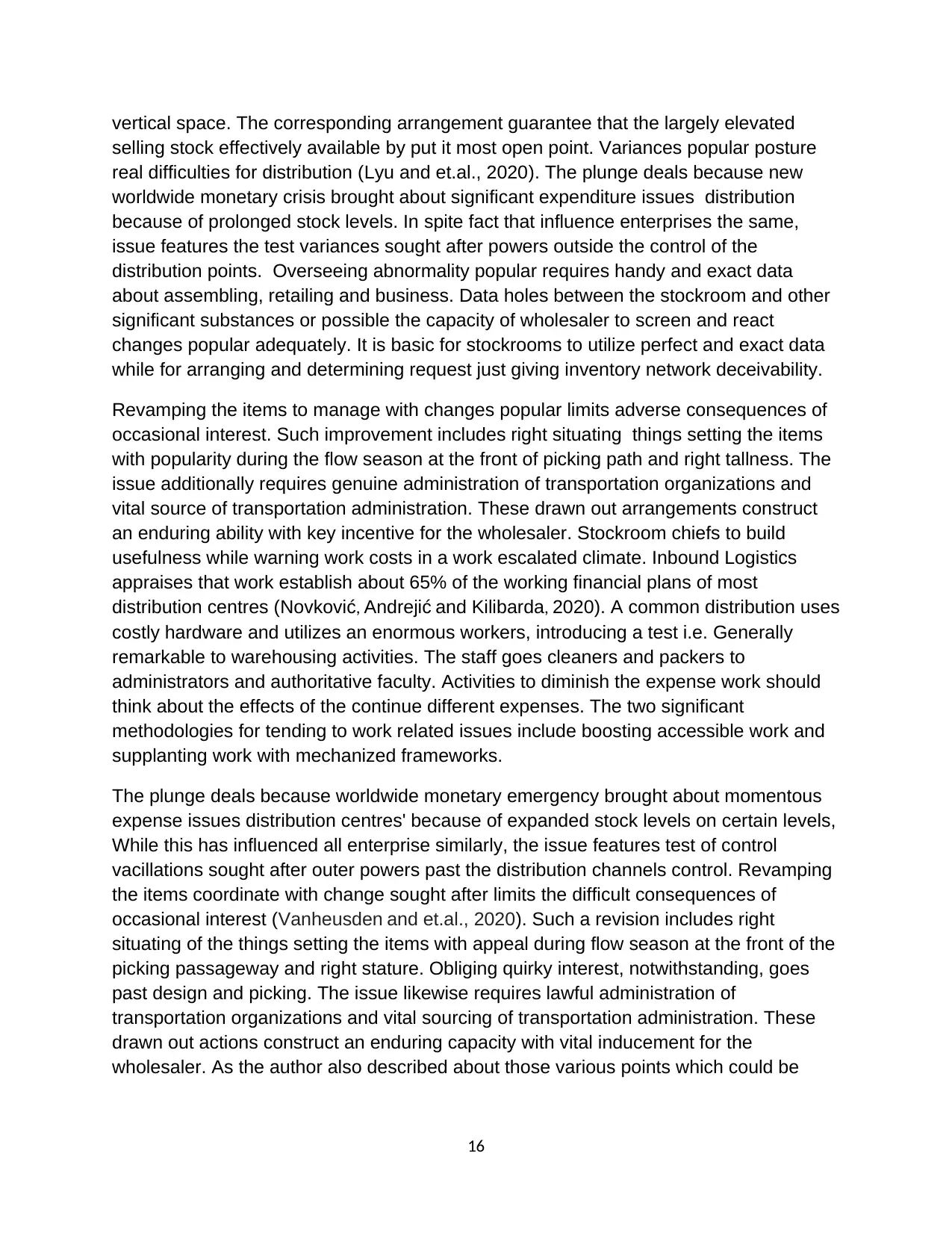
vertical space. The corresponding arrangement guarantee that the largely elevated
selling stock effectively available by put it most open point. Variances popular posture
real difficulties for distribution (Lyu and et.al., 2020). The plunge deals because new
worldwide monetary crisis brought about significant expenditure issues distribution
because of prolonged stock levels. In spite fact that influence enterprises the same,
issue features the test variances sought after powers outside the control of the
distribution points. Overseeing abnormality popular requires handy and exact data
about assembling, retailing and business. Data holes between the stockroom and other
significant substances or possible the capacity of wholesaler to screen and react
changes popular adequately. It is basic for stockrooms to utilize perfect and exact data
while for arranging and determining request just giving inventory network deceivability.
Revamping the items to manage with changes popular limits adverse consequences of
occasional interest. Such improvement includes right situating things setting the items
with popularity during the flow season at the front of picking path and right tallness. The
issue additionally requires genuine administration of transportation organizations and
vital source of transportation administration. These drawn out arrangements construct
an enduring ability with key incentive for the wholesaler. Stockroom chiefs to build
usefulness while warning work costs in a work escalated climate. Inbound Logistics
appraises that work establish about 65% of the working financial plans of most
distribution centres (Novković, Andrejić and Kilibarda, 2020). A common distribution uses
costly hardware and utilizes an enormous workers, introducing a test i.e. Generally
remarkable to warehousing activities. The staff goes cleaners and packers to
administrators and authoritative faculty. Activities to diminish the expense work should
think about the effects of the continue different expenses. The two significant
methodologies for tending to work related issues include boosting accessible work and
supplanting work with mechanized frameworks.
The plunge deals because worldwide monetary emergency brought about momentous
expense issues distribution centres' because of expanded stock levels on certain levels,
While this has influenced all enterprise similarly, the issue features test of control
vacillations sought after outer powers past the distribution channels control. Revamping
the items coordinate with change sought after limits the difficult consequences of
occasional interest (Vanheusden and et.al., 2020). Such a revision includes right
situating of the things setting the items with appeal during flow season at the front of the
picking passageway and right stature. Obliging quirky interest, notwithstanding, goes
past design and picking. The issue likewise requires lawful administration of
transportation organizations and vital sourcing of transportation administration. These
drawn out actions construct an enduring capacity with vital inducement for the
wholesaler. As the author also described about those various points which could be
16
selling stock effectively available by put it most open point. Variances popular posture
real difficulties for distribution (Lyu and et.al., 2020). The plunge deals because new
worldwide monetary crisis brought about significant expenditure issues distribution
because of prolonged stock levels. In spite fact that influence enterprises the same,
issue features the test variances sought after powers outside the control of the
distribution points. Overseeing abnormality popular requires handy and exact data
about assembling, retailing and business. Data holes between the stockroom and other
significant substances or possible the capacity of wholesaler to screen and react
changes popular adequately. It is basic for stockrooms to utilize perfect and exact data
while for arranging and determining request just giving inventory network deceivability.
Revamping the items to manage with changes popular limits adverse consequences of
occasional interest. Such improvement includes right situating things setting the items
with popularity during the flow season at the front of picking path and right tallness. The
issue additionally requires genuine administration of transportation organizations and
vital source of transportation administration. These drawn out arrangements construct
an enduring ability with key incentive for the wholesaler. Stockroom chiefs to build
usefulness while warning work costs in a work escalated climate. Inbound Logistics
appraises that work establish about 65% of the working financial plans of most
distribution centres (Novković, Andrejić and Kilibarda, 2020). A common distribution uses
costly hardware and utilizes an enormous workers, introducing a test i.e. Generally
remarkable to warehousing activities. The staff goes cleaners and packers to
administrators and authoritative faculty. Activities to diminish the expense work should
think about the effects of the continue different expenses. The two significant
methodologies for tending to work related issues include boosting accessible work and
supplanting work with mechanized frameworks.
The plunge deals because worldwide monetary emergency brought about momentous
expense issues distribution centres' because of expanded stock levels on certain levels,
While this has influenced all enterprise similarly, the issue features test of control
vacillations sought after outer powers past the distribution channels control. Revamping
the items coordinate with change sought after limits the difficult consequences of
occasional interest (Vanheusden and et.al., 2020). Such a revision includes right
situating of the things setting the items with appeal during flow season at the front of the
picking passageway and right stature. Obliging quirky interest, notwithstanding, goes
past design and picking. The issue likewise requires lawful administration of
transportation organizations and vital sourcing of transportation administration. These
drawn out actions construct an enduring capacity with vital inducement for the
wholesaler. As the author also described about those various points which could be
16
Secure Best Marks with AI Grader
Need help grading? Try our AI Grader for instant feedback on your assignments.
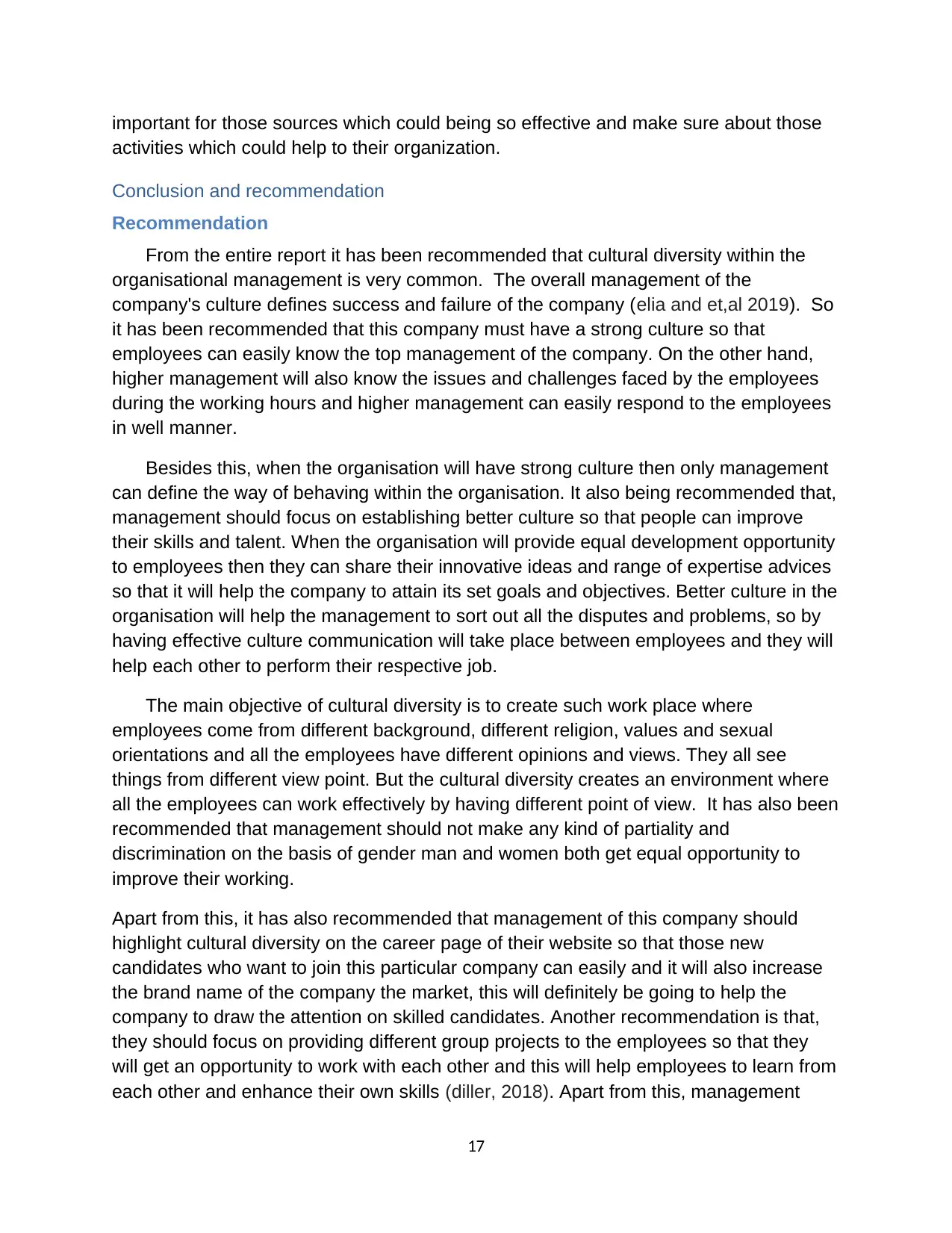
important for those sources which could being so effective and make sure about those
activities which could help to their organization.
Conclusion and recommendation
Recommendation
From the entire report it has been recommended that cultural diversity within the
organisational management is very common. The overall management of the
company's culture defines success and failure of the company (elia and et,al 2019). So
it has been recommended that this company must have a strong culture so that
employees can easily know the top management of the company. On the other hand,
higher management will also know the issues and challenges faced by the employees
during the working hours and higher management can easily respond to the employees
in well manner.
Besides this, when the organisation will have strong culture then only management
can define the way of behaving within the organisation. It also being recommended that,
management should focus on establishing better culture so that people can improve
their skills and talent. When the organisation will provide equal development opportunity
to employees then they can share their innovative ideas and range of expertise advices
so that it will help the company to attain its set goals and objectives. Better culture in the
organisation will help the management to sort out all the disputes and problems, so by
having effective culture communication will take place between employees and they will
help each other to perform their respective job.
The main objective of cultural diversity is to create such work place where
employees come from different background, different religion, values and sexual
orientations and all the employees have different opinions and views. They all see
things from different view point. But the cultural diversity creates an environment where
all the employees can work effectively by having different point of view. It has also been
recommended that management should not make any kind of partiality and
discrimination on the basis of gender man and women both get equal opportunity to
improve their working.
Apart from this, it has also recommended that management of this company should
highlight cultural diversity on the career page of their website so that those new
candidates who want to join this particular company can easily and it will also increase
the brand name of the company the market, this will definitely be going to help the
company to draw the attention on skilled candidates. Another recommendation is that,
they should focus on providing different group projects to the employees so that they
will get an opportunity to work with each other and this will help employees to learn from
each other and enhance their own skills (diller, 2018). Apart from this, management
17
activities which could help to their organization.
Conclusion and recommendation
Recommendation
From the entire report it has been recommended that cultural diversity within the
organisational management is very common. The overall management of the
company's culture defines success and failure of the company (elia and et,al 2019). So
it has been recommended that this company must have a strong culture so that
employees can easily know the top management of the company. On the other hand,
higher management will also know the issues and challenges faced by the employees
during the working hours and higher management can easily respond to the employees
in well manner.
Besides this, when the organisation will have strong culture then only management
can define the way of behaving within the organisation. It also being recommended that,
management should focus on establishing better culture so that people can improve
their skills and talent. When the organisation will provide equal development opportunity
to employees then they can share their innovative ideas and range of expertise advices
so that it will help the company to attain its set goals and objectives. Better culture in the
organisation will help the management to sort out all the disputes and problems, so by
having effective culture communication will take place between employees and they will
help each other to perform their respective job.
The main objective of cultural diversity is to create such work place where
employees come from different background, different religion, values and sexual
orientations and all the employees have different opinions and views. They all see
things from different view point. But the cultural diversity creates an environment where
all the employees can work effectively by having different point of view. It has also been
recommended that management should not make any kind of partiality and
discrimination on the basis of gender man and women both get equal opportunity to
improve their working.
Apart from this, it has also recommended that management of this company should
highlight cultural diversity on the career page of their website so that those new
candidates who want to join this particular company can easily and it will also increase
the brand name of the company the market, this will definitely be going to help the
company to draw the attention on skilled candidates. Another recommendation is that,
they should focus on providing different group projects to the employees so that they
will get an opportunity to work with each other and this will help employees to learn from
each other and enhance their own skills (diller, 2018). Apart from this, management
17
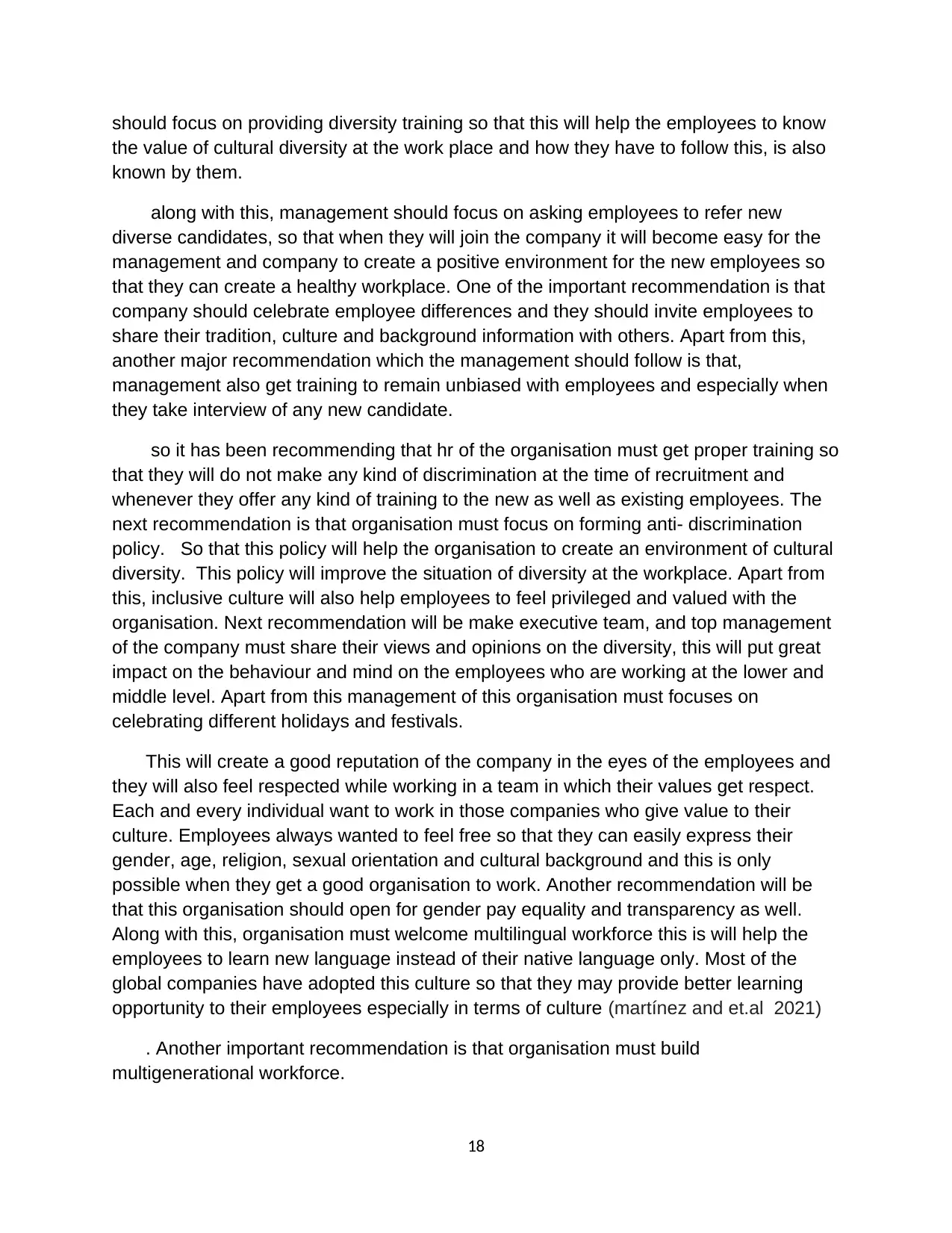
should focus on providing diversity training so that this will help the employees to know
the value of cultural diversity at the work place and how they have to follow this, is also
known by them.
along with this, management should focus on asking employees to refer new
diverse candidates, so that when they will join the company it will become easy for the
management and company to create a positive environment for the new employees so
that they can create a healthy workplace. One of the important recommendation is that
company should celebrate employee differences and they should invite employees to
share their tradition, culture and background information with others. Apart from this,
another major recommendation which the management should follow is that,
management also get training to remain unbiased with employees and especially when
they take interview of any new candidate.
so it has been recommending that hr of the organisation must get proper training so
that they will do not make any kind of discrimination at the time of recruitment and
whenever they offer any kind of training to the new as well as existing employees. The
next recommendation is that organisation must focus on forming anti- discrimination
policy. So that this policy will help the organisation to create an environment of cultural
diversity. This policy will improve the situation of diversity at the workplace. Apart from
this, inclusive culture will also help employees to feel privileged and valued with the
organisation. Next recommendation will be make executive team, and top management
of the company must share their views and opinions on the diversity, this will put great
impact on the behaviour and mind on the employees who are working at the lower and
middle level. Apart from this management of this organisation must focuses on
celebrating different holidays and festivals.
This will create a good reputation of the company in the eyes of the employees and
they will also feel respected while working in a team in which their values get respect.
Each and every individual want to work in those companies who give value to their
culture. Employees always wanted to feel free so that they can easily express their
gender, age, religion, sexual orientation and cultural background and this is only
possible when they get a good organisation to work. Another recommendation will be
that this organisation should open for gender pay equality and transparency as well.
Along with this, organisation must welcome multilingual workforce this is will help the
employees to learn new language instead of their native language only. Most of the
global companies have adopted this culture so that they may provide better learning
opportunity to their employees especially in terms of culture (martínez and et.al 2021)
. Another important recommendation is that organisation must build
multigenerational workforce.
18
the value of cultural diversity at the work place and how they have to follow this, is also
known by them.
along with this, management should focus on asking employees to refer new
diverse candidates, so that when they will join the company it will become easy for the
management and company to create a positive environment for the new employees so
that they can create a healthy workplace. One of the important recommendation is that
company should celebrate employee differences and they should invite employees to
share their tradition, culture and background information with others. Apart from this,
another major recommendation which the management should follow is that,
management also get training to remain unbiased with employees and especially when
they take interview of any new candidate.
so it has been recommending that hr of the organisation must get proper training so
that they will do not make any kind of discrimination at the time of recruitment and
whenever they offer any kind of training to the new as well as existing employees. The
next recommendation is that organisation must focus on forming anti- discrimination
policy. So that this policy will help the organisation to create an environment of cultural
diversity. This policy will improve the situation of diversity at the workplace. Apart from
this, inclusive culture will also help employees to feel privileged and valued with the
organisation. Next recommendation will be make executive team, and top management
of the company must share their views and opinions on the diversity, this will put great
impact on the behaviour and mind on the employees who are working at the lower and
middle level. Apart from this management of this organisation must focuses on
celebrating different holidays and festivals.
This will create a good reputation of the company in the eyes of the employees and
they will also feel respected while working in a team in which their values get respect.
Each and every individual want to work in those companies who give value to their
culture. Employees always wanted to feel free so that they can easily express their
gender, age, religion, sexual orientation and cultural background and this is only
possible when they get a good organisation to work. Another recommendation will be
that this organisation should open for gender pay equality and transparency as well.
Along with this, organisation must welcome multilingual workforce this is will help the
employees to learn new language instead of their native language only. Most of the
global companies have adopted this culture so that they may provide better learning
opportunity to their employees especially in terms of culture (martínez and et.al 2021)
. Another important recommendation is that organisation must build
multigenerational workforce.
18
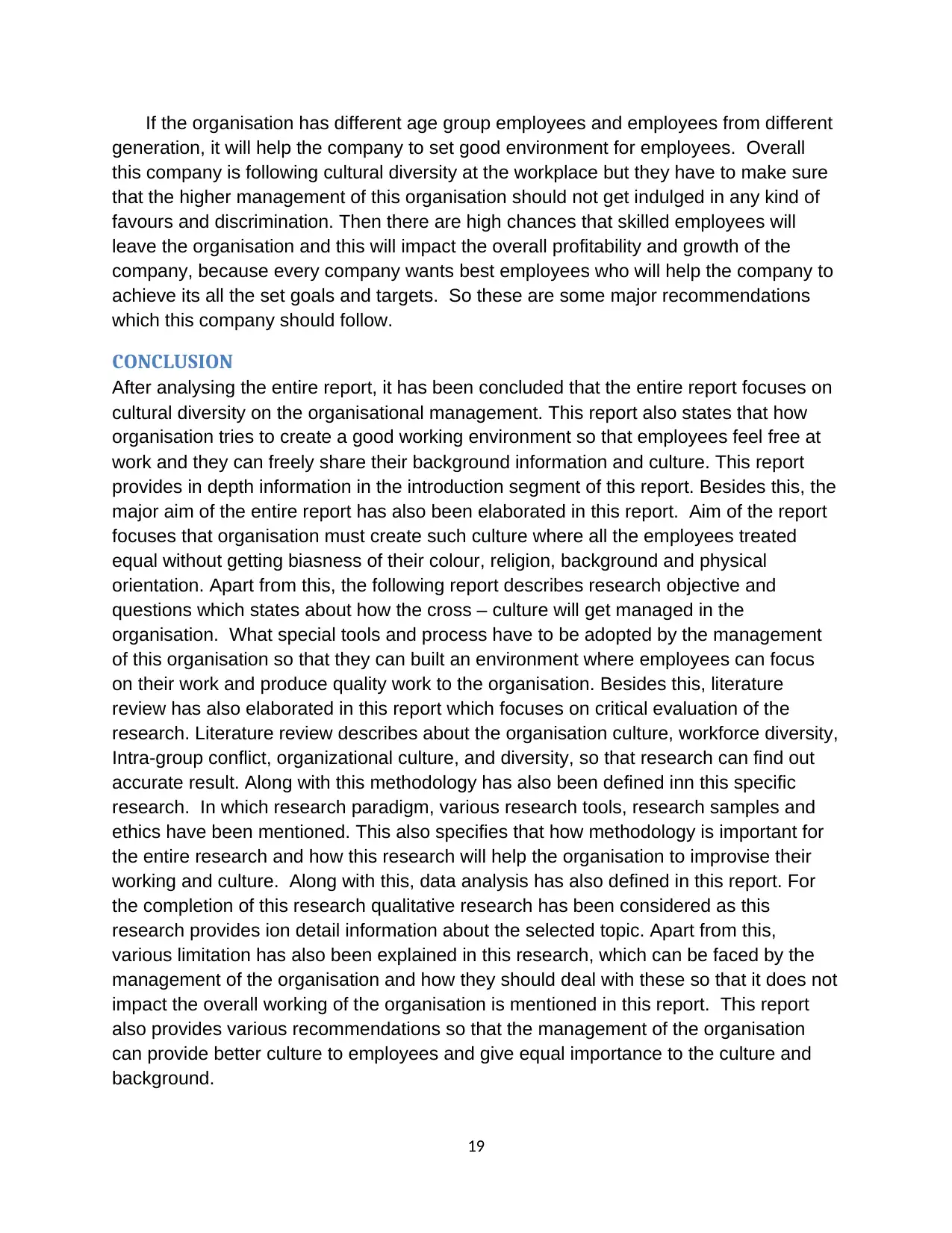
If the organisation has different age group employees and employees from different
generation, it will help the company to set good environment for employees. Overall
this company is following cultural diversity at the workplace but they have to make sure
that the higher management of this organisation should not get indulged in any kind of
favours and discrimination. Then there are high chances that skilled employees will
leave the organisation and this will impact the overall profitability and growth of the
company, because every company wants best employees who will help the company to
achieve its all the set goals and targets. So these are some major recommendations
which this company should follow.
CONCLUSION
After analysing the entire report, it has been concluded that the entire report focuses on
cultural diversity on the organisational management. This report also states that how
organisation tries to create a good working environment so that employees feel free at
work and they can freely share their background information and culture. This report
provides in depth information in the introduction segment of this report. Besides this, the
major aim of the entire report has also been elaborated in this report. Aim of the report
focuses that organisation must create such culture where all the employees treated
equal without getting biasness of their colour, religion, background and physical
orientation. Apart from this, the following report describes research objective and
questions which states about how the cross – culture will get managed in the
organisation. What special tools and process have to be adopted by the management
of this organisation so that they can built an environment where employees can focus
on their work and produce quality work to the organisation. Besides this, literature
review has also elaborated in this report which focuses on critical evaluation of the
research. Literature review describes about the organisation culture, workforce diversity,
Intra-group conflict, organizational culture, and diversity, so that research can find out
accurate result. Along with this methodology has also been defined inn this specific
research. In which research paradigm, various research tools, research samples and
ethics have been mentioned. This also specifies that how methodology is important for
the entire research and how this research will help the organisation to improvise their
working and culture. Along with this, data analysis has also defined in this report. For
the completion of this research qualitative research has been considered as this
research provides ion detail information about the selected topic. Apart from this,
various limitation has also been explained in this research, which can be faced by the
management of the organisation and how they should deal with these so that it does not
impact the overall working of the organisation is mentioned in this report. This report
also provides various recommendations so that the management of the organisation
can provide better culture to employees and give equal importance to the culture and
background.
19
generation, it will help the company to set good environment for employees. Overall
this company is following cultural diversity at the workplace but they have to make sure
that the higher management of this organisation should not get indulged in any kind of
favours and discrimination. Then there are high chances that skilled employees will
leave the organisation and this will impact the overall profitability and growth of the
company, because every company wants best employees who will help the company to
achieve its all the set goals and targets. So these are some major recommendations
which this company should follow.
CONCLUSION
After analysing the entire report, it has been concluded that the entire report focuses on
cultural diversity on the organisational management. This report also states that how
organisation tries to create a good working environment so that employees feel free at
work and they can freely share their background information and culture. This report
provides in depth information in the introduction segment of this report. Besides this, the
major aim of the entire report has also been elaborated in this report. Aim of the report
focuses that organisation must create such culture where all the employees treated
equal without getting biasness of their colour, religion, background and physical
orientation. Apart from this, the following report describes research objective and
questions which states about how the cross – culture will get managed in the
organisation. What special tools and process have to be adopted by the management
of this organisation so that they can built an environment where employees can focus
on their work and produce quality work to the organisation. Besides this, literature
review has also elaborated in this report which focuses on critical evaluation of the
research. Literature review describes about the organisation culture, workforce diversity,
Intra-group conflict, organizational culture, and diversity, so that research can find out
accurate result. Along with this methodology has also been defined inn this specific
research. In which research paradigm, various research tools, research samples and
ethics have been mentioned. This also specifies that how methodology is important for
the entire research and how this research will help the organisation to improvise their
working and culture. Along with this, data analysis has also defined in this report. For
the completion of this research qualitative research has been considered as this
research provides ion detail information about the selected topic. Apart from this,
various limitation has also been explained in this research, which can be faced by the
management of the organisation and how they should deal with these so that it does not
impact the overall working of the organisation is mentioned in this report. This report
also provides various recommendations so that the management of the organisation
can provide better culture to employees and give equal importance to the culture and
background.
19
Paraphrase This Document
Need a fresh take? Get an instant paraphrase of this document with our AI Paraphraser
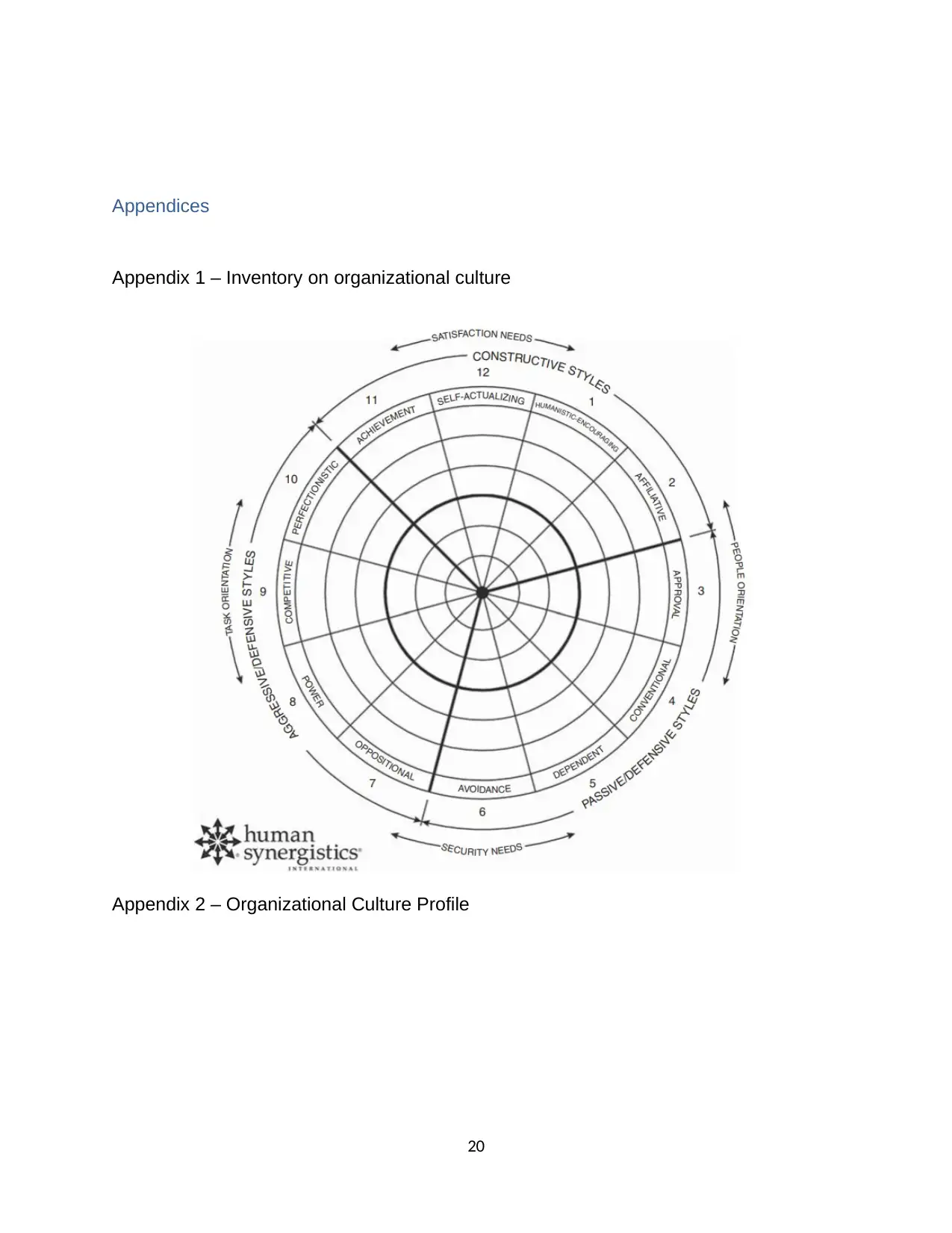
Appendices
Appendix 1 – Inventory on organizational culture
Appendix 2 – Organizational Culture Profile
20
Appendix 1 – Inventory on organizational culture
Appendix 2 – Organizational Culture Profile
20
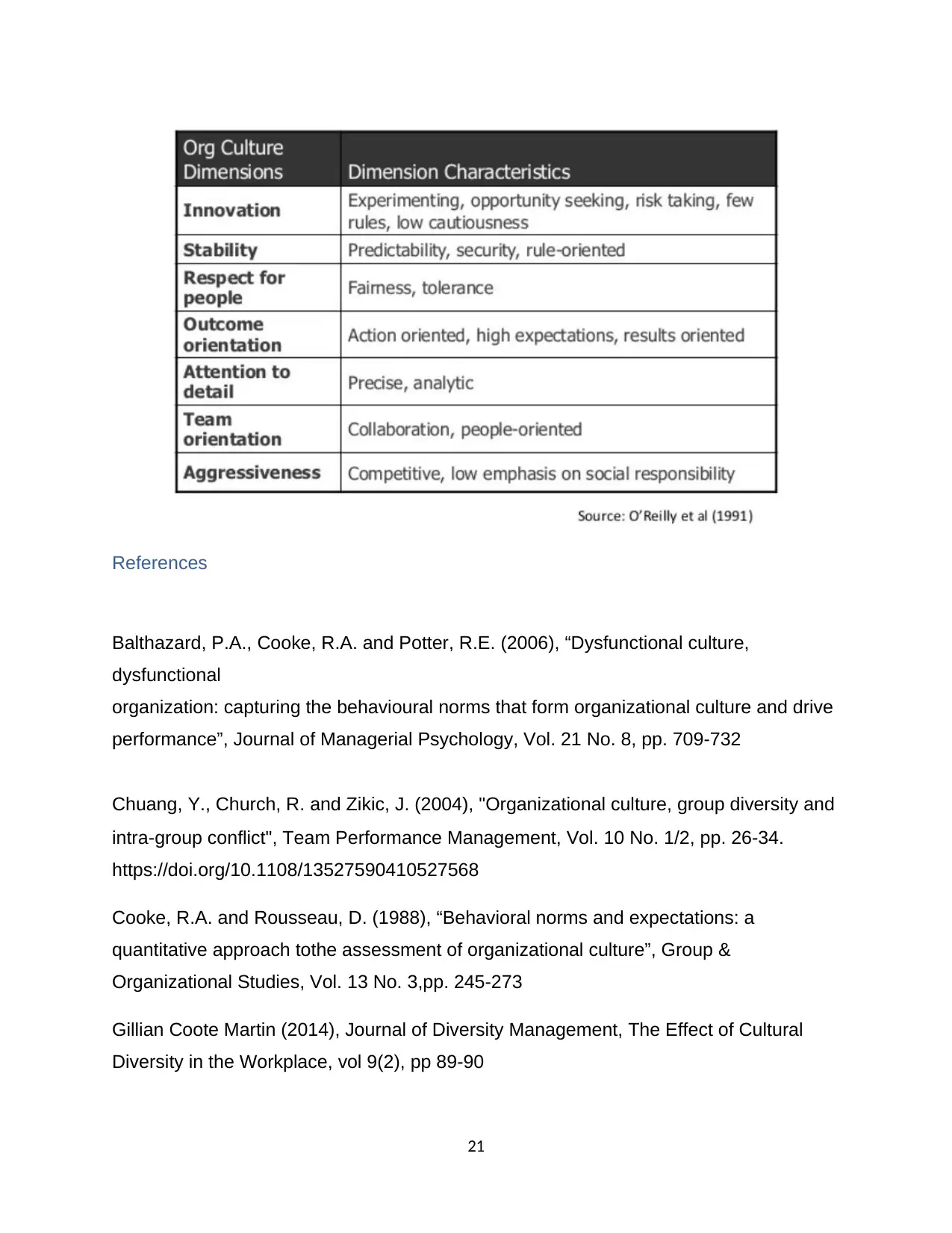
References
Balthazard, P.A., Cooke, R.A. and Potter, R.E. (2006), “Dysfunctional culture,
dysfunctional
organization: capturing the behavioural norms that form organizational culture and drive
performance”, Journal of Managerial Psychology, Vol. 21 No. 8, pp. 709-732
Chuang, Y., Church, R. and Zikic, J. (2004), "Organizational culture, group diversity and
intra‐group conflict", Team Performance Management, Vol. 10 No. 1/2, pp. 26-34.
https://doi.org/10.1108/13527590410527568
Cooke, R.A. and Rousseau, D. (1988), “Behavioral norms and expectations: a
quantitative approach tothe assessment of organizational culture”, Group &
Organizational Studies, Vol. 13 No. 3,pp. 245-273
Gillian Coote Martin (2014), Journal of Diversity Management, The Effect of Cultural
Diversity in the Workplace, vol 9(2), pp 89-90
21
Balthazard, P.A., Cooke, R.A. and Potter, R.E. (2006), “Dysfunctional culture,
dysfunctional
organization: capturing the behavioural norms that form organizational culture and drive
performance”, Journal of Managerial Psychology, Vol. 21 No. 8, pp. 709-732
Chuang, Y., Church, R. and Zikic, J. (2004), "Organizational culture, group diversity and
intra‐group conflict", Team Performance Management, Vol. 10 No. 1/2, pp. 26-34.
https://doi.org/10.1108/13527590410527568
Cooke, R.A. and Rousseau, D. (1988), “Behavioral norms and expectations: a
quantitative approach tothe assessment of organizational culture”, Group &
Organizational Studies, Vol. 13 No. 3,pp. 245-273
Gillian Coote Martin (2014), Journal of Diversity Management, The Effect of Cultural
Diversity in the Workplace, vol 9(2), pp 89-90
21
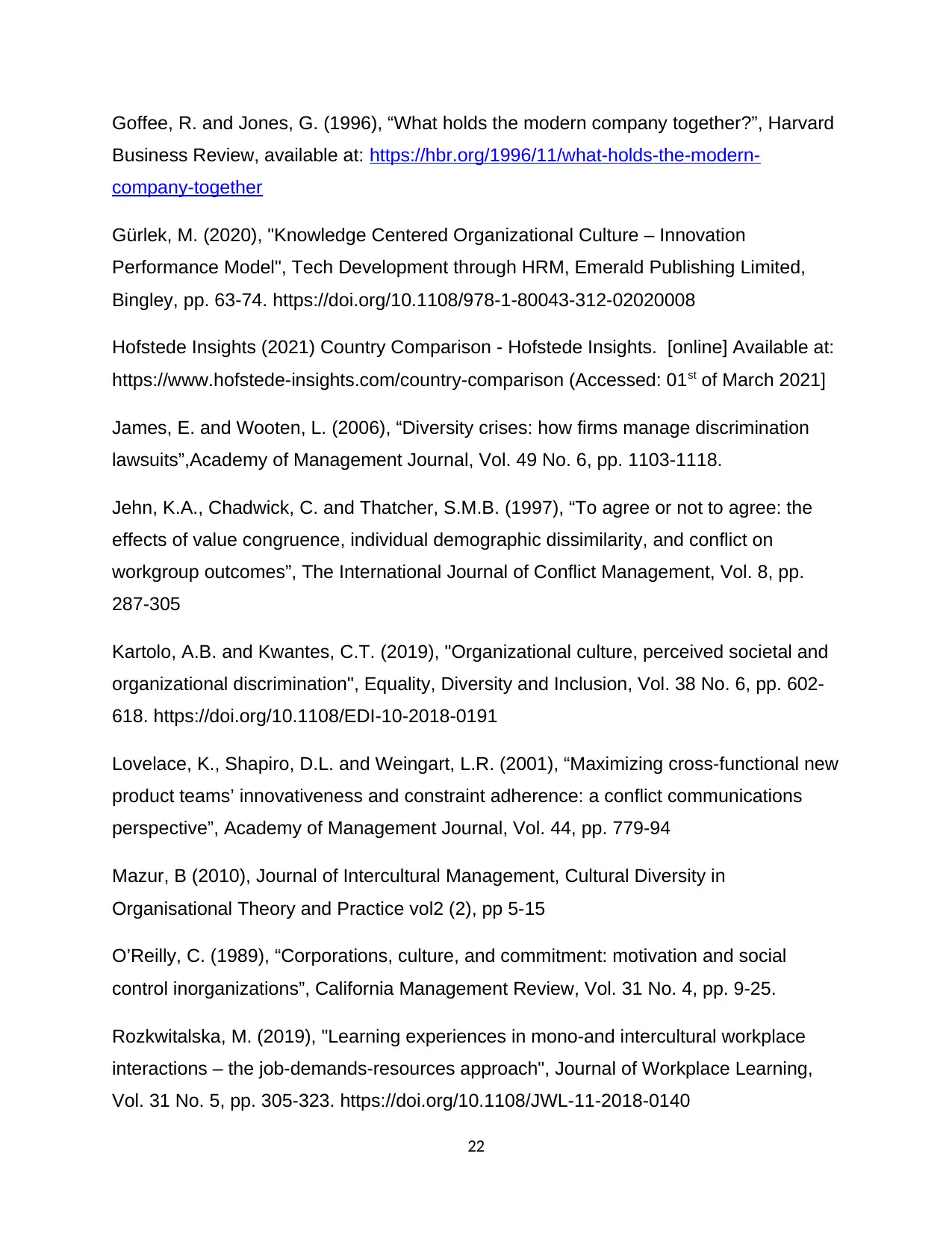
Goffee, R. and Jones, G. (1996), “What holds the modern company together?”, Harvard
Business Review, available at: https://hbr.org/1996/11/what-holds-the-modern-
company-together
Gürlek, M. (2020), "Knowledge Centered Organizational Culture – Innovation
Performance Model", Tech Development through HRM, Emerald Publishing Limited,
Bingley, pp. 63-74. https://doi.org/10.1108/978-1-80043-312-02020008
Hofstede Insights (2021) Country Comparison - Hofstede Insights. [online] Available at:
https://www.hofstede-insights.com/country-comparison (Accessed: 01st of March 2021]
James, E. and Wooten, L. (2006), “Diversity crises: how firms manage discrimination
lawsuits”,Academy of Management Journal, Vol. 49 No. 6, pp. 1103-1118.
Jehn, K.A., Chadwick, C. and Thatcher, S.M.B. (1997), “To agree or not to agree: the
effects of value congruence, individual demographic dissimilarity, and conflict on
workgroup outcomes”, The International Journal of Conflict Management, Vol. 8, pp.
287-305
Kartolo, A.B. and Kwantes, C.T. (2019), "Organizational culture, perceived societal and
organizational discrimination", Equality, Diversity and Inclusion, Vol. 38 No. 6, pp. 602-
618. https://doi.org/10.1108/EDI-10-2018-0191
Lovelace, K., Shapiro, D.L. and Weingart, L.R. (2001), “Maximizing cross-functional new
product teams’ innovativeness and constraint adherence: a conflict communications
perspective”, Academy of Management Journal, Vol. 44, pp. 779-94
Mazur, B (2010), Journal of Intercultural Management, Cultural Diversity in
Organisational Theory and Practice vol2 (2), pp 5-15
O’Reilly, C. (1989), “Corporations, culture, and commitment: motivation and social
control inorganizations”, California Management Review, Vol. 31 No. 4, pp. 9-25.
Rozkwitalska, M. (2019), "Learning experiences in mono-and intercultural workplace
interactions – the job-demands-resources approach", Journal of Workplace Learning,
Vol. 31 No. 5, pp. 305-323. https://doi.org/10.1108/JWL-11-2018-0140
22
Business Review, available at: https://hbr.org/1996/11/what-holds-the-modern-
company-together
Gürlek, M. (2020), "Knowledge Centered Organizational Culture – Innovation
Performance Model", Tech Development through HRM, Emerald Publishing Limited,
Bingley, pp. 63-74. https://doi.org/10.1108/978-1-80043-312-02020008
Hofstede Insights (2021) Country Comparison - Hofstede Insights. [online] Available at:
https://www.hofstede-insights.com/country-comparison (Accessed: 01st of March 2021]
James, E. and Wooten, L. (2006), “Diversity crises: how firms manage discrimination
lawsuits”,Academy of Management Journal, Vol. 49 No. 6, pp. 1103-1118.
Jehn, K.A., Chadwick, C. and Thatcher, S.M.B. (1997), “To agree or not to agree: the
effects of value congruence, individual demographic dissimilarity, and conflict on
workgroup outcomes”, The International Journal of Conflict Management, Vol. 8, pp.
287-305
Kartolo, A.B. and Kwantes, C.T. (2019), "Organizational culture, perceived societal and
organizational discrimination", Equality, Diversity and Inclusion, Vol. 38 No. 6, pp. 602-
618. https://doi.org/10.1108/EDI-10-2018-0191
Lovelace, K., Shapiro, D.L. and Weingart, L.R. (2001), “Maximizing cross-functional new
product teams’ innovativeness and constraint adherence: a conflict communications
perspective”, Academy of Management Journal, Vol. 44, pp. 779-94
Mazur, B (2010), Journal of Intercultural Management, Cultural Diversity in
Organisational Theory and Practice vol2 (2), pp 5-15
O’Reilly, C. (1989), “Corporations, culture, and commitment: motivation and social
control inorganizations”, California Management Review, Vol. 31 No. 4, pp. 9-25.
Rozkwitalska, M. (2019), "Learning experiences in mono-and intercultural workplace
interactions – the job-demands-resources approach", Journal of Workplace Learning,
Vol. 31 No. 5, pp. 305-323. https://doi.org/10.1108/JWL-11-2018-0140
22
Secure Best Marks with AI Grader
Need help grading? Try our AI Grader for instant feedback on your assignments.
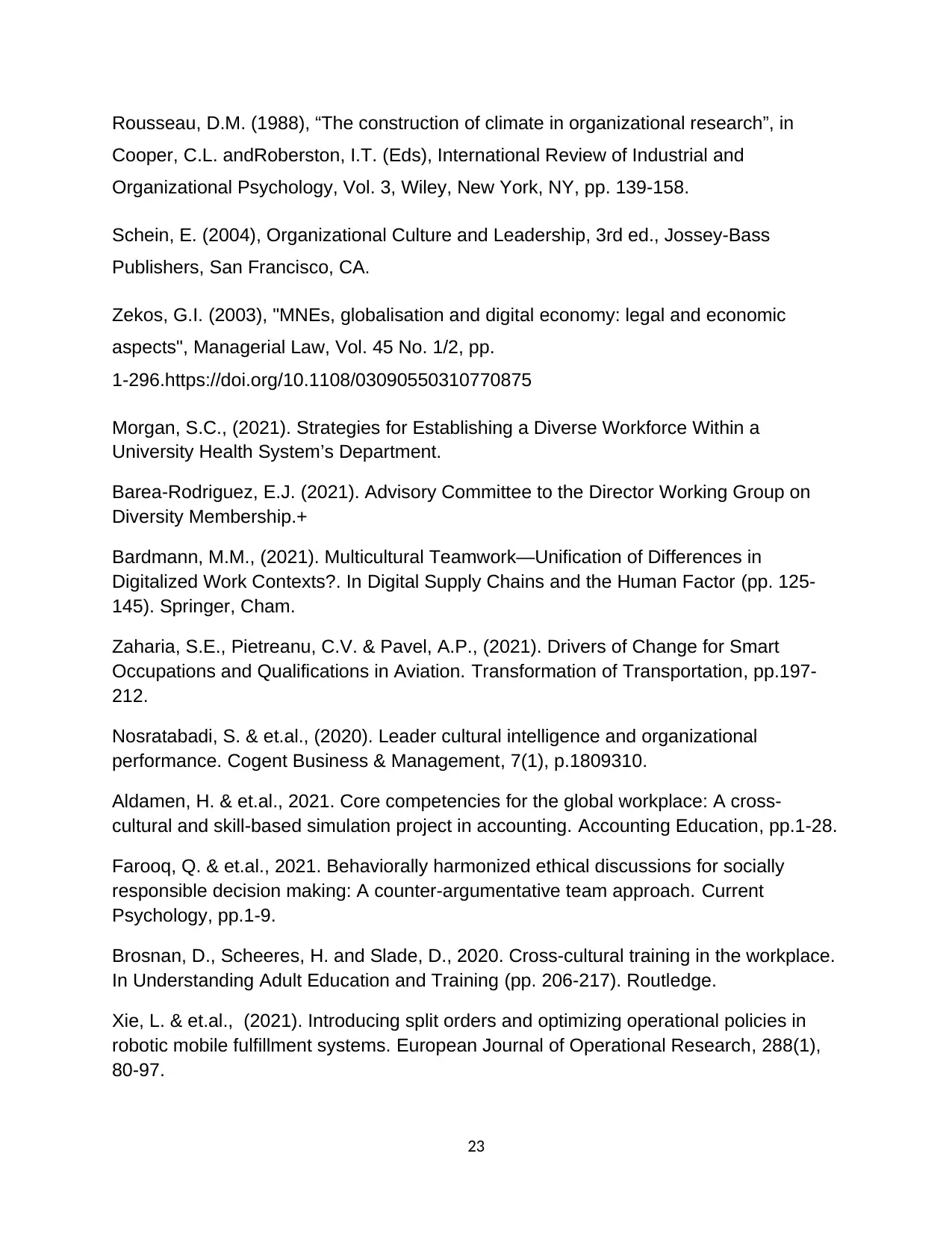
Rousseau, D.M. (1988), “The construction of climate in organizational research”, in
Cooper, C.L. andRoberston, I.T. (Eds), International Review of Industrial and
Organizational Psychology, Vol. 3, Wiley, New York, NY, pp. 139-158.
Schein, E. (2004), Organizational Culture and Leadership, 3rd ed., Jossey-Bass
Publishers, San Francisco, CA.
Zekos, G.I. (2003), "MNEs, globalisation and digital economy: legal and economic
aspects", Managerial Law, Vol. 45 No. 1/2, pp.
1-296.https://doi.org/10.1108/03090550310770875
Morgan, S.C., (2021). Strategies for Establishing a Diverse Workforce Within a
University Health System’s Department.
Barea-Rodriguez, E.J. (2021). Advisory Committee to the Director Working Group on
Diversity Membership.+
Bardmann, M.M., (2021). Multicultural Teamwork—Unification of Differences in
Digitalized Work Contexts?. In Digital Supply Chains and the Human Factor (pp. 125-
145). Springer, Cham.
Zaharia, S.E., Pietreanu, C.V. & Pavel, A.P., (2021). Drivers of Change for Smart
Occupations and Qualifications in Aviation. Transformation of Transportation, pp.197-
212.
Nosratabadi, S. & et.al., (2020). Leader cultural intelligence and organizational
performance. Cogent Business & Management, 7(1), p.1809310.
Aldamen, H. & et.al., 2021. Core competencies for the global workplace: A cross-
cultural and skill-based simulation project in accounting. Accounting Education, pp.1-28.
Farooq, Q. & et.al., 2021. Behaviorally harmonized ethical discussions for socially
responsible decision making: A counter-argumentative team approach. Current
Psychology, pp.1-9.
Brosnan, D., Scheeres, H. and Slade, D., 2020. Cross-cultural training in the workplace.
In Understanding Adult Education and Training (pp. 206-217). Routledge.
Xie, L. & et.al., (2021). Introducing split orders and optimizing operational policies in
robotic mobile fulfillment systems. European Journal of Operational Research, 288(1),
80-97.
23
Cooper, C.L. andRoberston, I.T. (Eds), International Review of Industrial and
Organizational Psychology, Vol. 3, Wiley, New York, NY, pp. 139-158.
Schein, E. (2004), Organizational Culture and Leadership, 3rd ed., Jossey-Bass
Publishers, San Francisco, CA.
Zekos, G.I. (2003), "MNEs, globalisation and digital economy: legal and economic
aspects", Managerial Law, Vol. 45 No. 1/2, pp.
1-296.https://doi.org/10.1108/03090550310770875
Morgan, S.C., (2021). Strategies for Establishing a Diverse Workforce Within a
University Health System’s Department.
Barea-Rodriguez, E.J. (2021). Advisory Committee to the Director Working Group on
Diversity Membership.+
Bardmann, M.M., (2021). Multicultural Teamwork—Unification of Differences in
Digitalized Work Contexts?. In Digital Supply Chains and the Human Factor (pp. 125-
145). Springer, Cham.
Zaharia, S.E., Pietreanu, C.V. & Pavel, A.P., (2021). Drivers of Change for Smart
Occupations and Qualifications in Aviation. Transformation of Transportation, pp.197-
212.
Nosratabadi, S. & et.al., (2020). Leader cultural intelligence and organizational
performance. Cogent Business & Management, 7(1), p.1809310.
Aldamen, H. & et.al., 2021. Core competencies for the global workplace: A cross-
cultural and skill-based simulation project in accounting. Accounting Education, pp.1-28.
Farooq, Q. & et.al., 2021. Behaviorally harmonized ethical discussions for socially
responsible decision making: A counter-argumentative team approach. Current
Psychology, pp.1-9.
Brosnan, D., Scheeres, H. and Slade, D., 2020. Cross-cultural training in the workplace.
In Understanding Adult Education and Training (pp. 206-217). Routledge.
Xie, L. & et.al., (2021). Introducing split orders and optimizing operational policies in
robotic mobile fulfillment systems. European Journal of Operational Research, 288(1),
80-97.
23
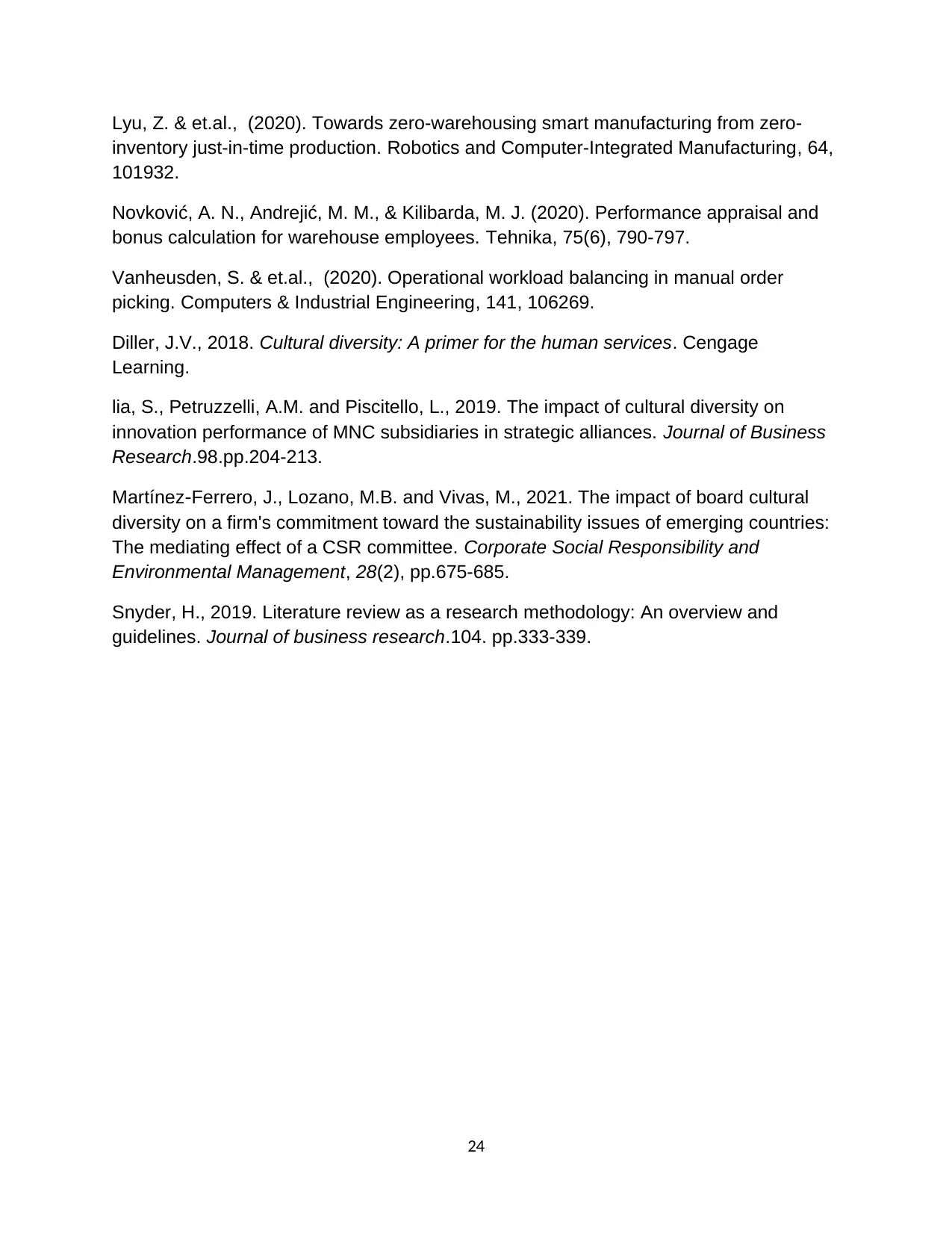
Lyu, Z. & et.al., (2020). Towards zero-warehousing smart manufacturing from zero-
inventory just-in-time production. Robotics and Computer-Integrated Manufacturing, 64,
101932.
Novković, A. N., Andrejić, M. M., & Kilibarda, M. J. (2020). Performance appraisal and
bonus calculation for warehouse employees. Tehnika, 75(6), 790-797.
Vanheusden, S. & et.al., (2020). Operational workload balancing in manual order
picking. Computers & Industrial Engineering, 141, 106269.
Diller, J.V., 2018. Cultural diversity: A primer for the human services. Cengage
Learning.
lia, S., Petruzzelli, A.M. and Piscitello, L., 2019. The impact of cultural diversity on
innovation performance of MNC subsidiaries in strategic alliances. Journal of Business
Research.98.pp.204-213.
Martínez‐Ferrero, J., Lozano, M.B. and Vivas, M., 2021. The impact of board cultural
diversity on a firm's commitment toward the sustainability issues of emerging countries:
The mediating effect of a CSR committee. Corporate Social Responsibility and
Environmental Management, 28(2), pp.675-685.
Snyder, H., 2019. Literature review as a research methodology: An overview and
guidelines. Journal of business research.104. pp.333-339.
24
inventory just-in-time production. Robotics and Computer-Integrated Manufacturing, 64,
101932.
Novković, A. N., Andrejić, M. M., & Kilibarda, M. J. (2020). Performance appraisal and
bonus calculation for warehouse employees. Tehnika, 75(6), 790-797.
Vanheusden, S. & et.al., (2020). Operational workload balancing in manual order
picking. Computers & Industrial Engineering, 141, 106269.
Diller, J.V., 2018. Cultural diversity: A primer for the human services. Cengage
Learning.
lia, S., Petruzzelli, A.M. and Piscitello, L., 2019. The impact of cultural diversity on
innovation performance of MNC subsidiaries in strategic alliances. Journal of Business
Research.98.pp.204-213.
Martínez‐Ferrero, J., Lozano, M.B. and Vivas, M., 2021. The impact of board cultural
diversity on a firm's commitment toward the sustainability issues of emerging countries:
The mediating effect of a CSR committee. Corporate Social Responsibility and
Environmental Management, 28(2), pp.675-685.
Snyder, H., 2019. Literature review as a research methodology: An overview and
guidelines. Journal of business research.104. pp.333-339.
24
1 out of 24
Related Documents
Your All-in-One AI-Powered Toolkit for Academic Success.
+13062052269
info@desklib.com
Available 24*7 on WhatsApp / Email
![[object Object]](/_next/static/media/star-bottom.7253800d.svg)
Unlock your academic potential
© 2024 | Zucol Services PVT LTD | All rights reserved.





